TP Link Technologies NC220 Day/Night Cloud Camera, 300Mbps Wi-Fi User Manual
TP-Link Technologies Co., Ltd. Day/Night Cloud Camera, 300Mbps Wi-Fi
User Manual
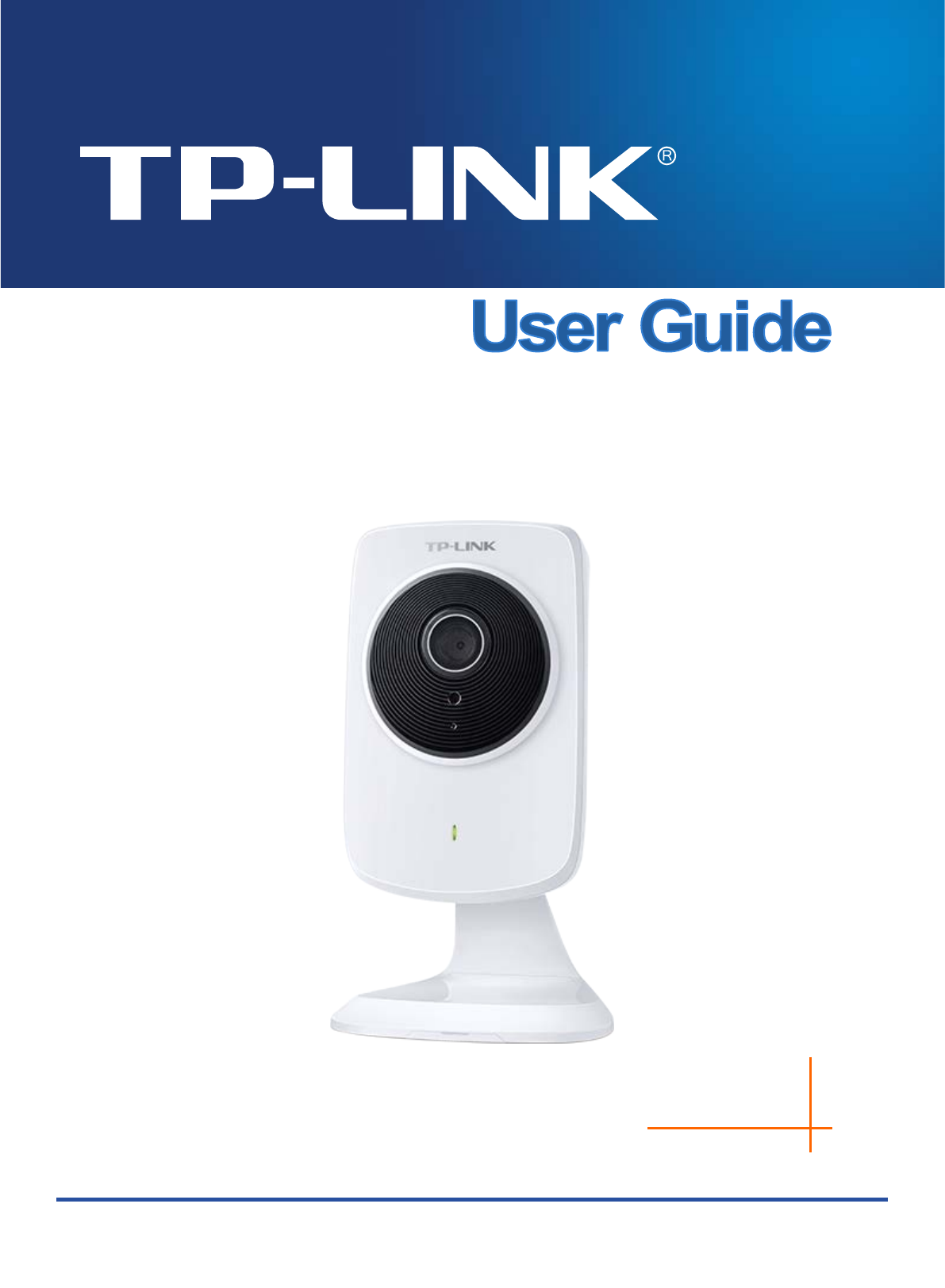
NC220
Day/Night Cloud Camera, 300Mbps Wi-Fi
1910011260
REV1.0.0

COPYRIGHT & TRADEMARKS
Specifications are subject to change without notice. is a registered trademark of
TP-LINK TECHNOLOGIES CO., LTD. Other brands and product names are trademarks or
registered trademarks of their respective holders.
No part of the specifications may be reproduced in any form or by any means or used to make any
derivative such as translation, transformation, or adaptation without permission from TP-LINK
TECHNOLOGIES CO., LTD. Copyright © 2015 TP-LINK TECHNOLOGIES CO., LTD. All rights
reserved.
http://www.tp-link.com

FCC STATEMENT
This equipment has been tested and found to comply with the limits for a Class B digital device,
pursuant to part 15 of the FCC Rules. These limits are designed to pro-vide reasonable protection
against harmful interference in a residential installation. This equipment generates, uses and can
radiate radio frequency energy and, if not in-stalled and used in accordance with the instructions,
may cause harmful interference to radio communications. However, there is no guarantee that
interference will not occur in a particular installation. If this equipment does cause harmful
interference to radio or television reception, which can be determined by turning the equipment off
and on, the user is encouraged to try to correct the interference by one or more of the following
measures:
• Reorient or relocate the receiving antenna.
• Increase the separation between the equipment and receiver.
• Connect the equipment into an outlet on a circuit different from that to which the receiver
is connected.
• Consult the dealer or an experienced radio/ TV technician for help.
This device complies with part 15 of the FCC Rules. Operation is subject to the following two
conditions:
1) This device may not cause harmful interference.
2) This device must accept any interference received, including interference that may cause
undesired operation.
Any changes or modifications not expressly approved by the party responsible for compliance
could void the user’s authority to operate the equipment.
Note: The manufacturer is not responsible for any radio or TV interference caused by unauthorized
modifications to this equipment. Such modifications could void the user’s authority to operate the
equipment.
FCC RF Radiation Exposure Statement:
This equipment complies with FCC RF radiation exposure limits set forth for an uncontrolled
environment. This device and its antenna must not be co-located or operating in conjunction with
any other antenna or transmitter.
“To comply with FCC RF exposure compliance requirements, this grant is applicable to only Mobile
Configurations. The antennas used for this transmitter must be installed to provide a separation
distance of at least 20 cm from all persons and must not be co-located or operating in conjunction
with any other antenna or transmitter.”
CE Mark Warning
This is a class B product. In a domestic environment, this product may cause radio interference, in
which case the user may be required to take adequate measures.
Canadian Compliance Statement
This device complies with Industry Canada license-exempt RSS standard(s). Operation is subject
to the following two conditions:
(1) This device may not cause interference, and
(2)This device must accept any interference, including interference that may cause undesired
operation of the device.
Cet appareil est conforme aux norms CNR exemptes de licence d’Industrie Canada. Le
fonctionnement est soumis aux deux conditions suivantes:
(1) cet appareil ne doit pas provoquer d’interférences et
(2) cet appareil doit accepter toute interférence, y compris celles susceptibles de provoquer un
fonctionnement non souhaité de l’appareil.
This device has been designed to operate with the antennas listed below, and having a maximum
gain of 3 dBi. Antennas not included in this list or having a gain greater than 3 dBi are strictly
prohibited for use with this device. The required antenna impedance is 50 ohms.
To reduce potential radio interference to other users, the antenna type and its gain should be so
chosen that the equivalent isotropically radiated power (e.i.r.p.) is not more than that permitted for
successful communication.
Industry Canada Statement
Complies with the Canadian ICES-003 Class B specifications.
Cet appareil numérique de la classe B est conforme à la norme NMB-003 du Canada.
This device complies with RSS 210 of Industry Canada. This Class B device meets all the
requirements of the Canadian interference-causing equipment regulations.
Cet appareil numérique de la Classe B respecte toutes les exigences du Règlement sur le
matériel brouilleur du Canada.
Korea Warning Statements:
당해 무선설비는 운용중 전파혼신 가능성이 있음.
NCC Notice & BSMI Notice
注意!
依據 低功率電波輻射性電機管理辦法
第十二條 經型式認證合格之低功率射頻電機,非經許可,公司、商號或使用者均不得擅自變更頻率、
加大功率或變更原設計之特性或功能。
第十四條 低功率射頻電機之使用不得影響飛航安全及干擾合法通行;經發現有干擾現象時,應立即
停用,並改善至無干擾時方得繼續使用。前項合法通信,指依電信規定作業之無線電信。低功率射
頻電機需忍受合法通信或工業、科學以及醫療用電波輻射性電機設備之干擾。
減少電磁波影響,請妥適使用。
安全諮詢及注意事項
●請使用原裝電源供應器或只能按照本產品注明的電源類型使用本產品。
Radiation Exposure Statement:
This equipment complies with IC radiation exposure limits set forth for an uncontrolled environment. This
equipment should be installed and operated with minimum distance 20cm between the radiator &
your body.
Déclaration d'exposition aux radiations:Cet équipement est conforme aux limites d'exposition aux
ryonnements IC établies pour un environnement non contrôlé. Cet équipement doit être installé et utilisé avec
un minimum de 20 cm de distance entre la source de rayonnement et votre corps.

●清潔本產品之前請先拔掉電源線。請勿使用液體、噴霧清潔劑或濕布進行清潔。
●注意防潮,請勿將水或其他液體潑灑到本產品上。
●插槽與開口供通風使用,以確保本產品的操作可靠並防止過熱,請勿堵塞或覆蓋開口。
●請勿將本產品置放於靠近熱源的地方。除非有正常的通風,否則不可放在密閉位置中。
●請不要私自打開機殼,不要嘗試自行維修本產品,請由授權的專業人士進行此項工作。
Продукт сертифіковано згідно с правилами системи УкрСЕПРО на відповідність вимогам
нормативних документів та вимогам, що передбачені чинними законодавчими актами
України.
Safety Information
When product has power button, the power button is one of the way to shut off the product;
when there is no power button, the only way to completely shut off power is to disconnect the
product or the power adapter from the power source.
Don’t disassemble the product, or make repairs yourself. You run the risk of electric shock and
voiding the limited warranty. If you need service, please contact us.
Avoid water and wet locations.
This product can be used in the following countries:
AT
BG
BY
CA
CZ
DE
DK
EE
ES
FI
FR
GB
GR
HU
IE
IT
LT
LV
MT
NL
NO
PL
PT
RO
RU
SE
SK
TR
UA
US

TP-LINK TECHNOLOGIES CO., LTD
DECLARATION OF CONFORMITY
For the following equipment:
Product Description: Day/Night Cloud Camera, 300Mbps Wi-Fi
Model No.: NC220
Trademark: TP-LINK
We declare under our own responsibility that the above products satisfy all the technical regulations
applicable to the product within the scope of Council Directives:
Directives 1999/5/EC, Directives 2004/108/EC, Directives 2006/95/EC, Directives 1999/519/EC,
Directives 2011/65/EU
The above product is in conformity with the following standards or other normative documents
EN 300 328 V1.8.1
EN 301 489-1 V1.9.2 & EN 301 489-17 V2.2.1
EN 55022: 2010 + AC: 2011
EN 55024: 2010
EN 61000-3-2: 2006 + A1: 2009 + A2: 2009
EN 61000-3-3: 2013
EN 60950-1: 2006 + A11: 2009 + A1: 2010 + A12: 2011
EN 62311: 2008
The product carries the CE Mark:
Person responsible for making this declaration:
Yang Hongliang
Product Manager of International Business
Date of issue: 2015
TP-LINK TECHNOLOGIES CO., LTD.
Building 24 (floors 1, 3, 4, 5), and 28 (floors 1-4) Central Science and Technology Park,
Shennan Rd, Nanshan, Shenzhen, China

TP-LINK TECHNOLOGIES CO., LTD
CONTENTS
Chapter 1 About this Guide .................................................................................... 1
1.1 Conventions ................................................................................................................... 1
1.2 Overview of This Guide .................................................................................................. 1
Chapter 2 Introduction ............................................................................................ 2
2.1 Overview ........................................................................................................................ 2
2.2 Main Features ................................................................................................................ 2
2.3 Appearance Description ................................................................................................. 3
2.3.1 Front Panel .......................................................................................................... 3
2.3.2 Rear Panel .......................................................................................................... 4
2.4 Mount the Camera ......................................................................................................... 5
2.4.1 The Screw Size ................................................................................................... 5
2.4.2 Mount the Camera............................................................................................... 5
Chapter 3 Managing the Camera............................................................................ 7
3.1 Login ............................................................................................................................... 7
3.2 Live View ........................................................................................................................ 8
3.3 Basic ............................................................................................................................. 10
3.3.1 Basic → Status ................................................................................................. 11
3.3.2 Basic → Network ............................................................................................. 12
3.3.3 Basic → Wireless Connection ......................................................................... 13
3.3.4 Basic → Cloud Setting ..................................................................................... 15
3.3.5 Basic → LED ................................................................................................... 16
3.4 Advanced ..................................................................................................................... 17
3.4.1 Advanced → Status ......................................................................................... 17
3.4.2 Advanced → Network ...................................................................................... 17
3.4.3 Advanced → Wireless Connection .................................................................. 21
3.4.4 Advanced → Wireless Extender ...................................................................... 23
3.4.5 Advanced → Cloud Setting ............................................................................. 24
3.4.6 Advanced → DDNS ......................................................................................... 24
3.4.7 Advanced → Video .......................................................................................... 25
3.4.8 Advanced → Motion Detection ........................................................................ 27
3.4.9 Advanced → Sound Detection ........................................................................ 28
3.4.10 Advanced → Notification Delivery ................................................................... 28
3.4.11 Advanced → LED ............................................................................................ 32
3.5 System ......................................................................................................................... 32
3.5.1 Account .............................................................................................................. 33
3.5.2 Date/Time .......................................................................................................... 35
3.5.3 Management ..................................................................................................... 37
3.5.4 System Log ....................................................................................................... 39
Appendix A: Specifications ................................................................................... 41
Appendix B: Troubleshooting ............................................................................... 43

NC220
Day/Night Cloud Camera, 300Mbps Wi-Fi
Chapter 1 About this Guide
This User Guide contains information for setup and management of NC220 Day/Night Cloud
Camera, 300Mbps Wi-Fi. Please read this guide carefully before operation.
1.1 Conventions
In this Guide the following conventions are used:
The camera or NC220 mentioned in this Guide stands for NC220 Day/Night Cloud Camera,
300Mbps Wi-Fi without any explanation.
Bold font indicates a button, a toolbar icon, menu or menu item.
Symbol in this Guide:
Symbol Description
Note:
Ignoring this type of note might result in a malfunction or damage to the
device.
1.2 Overview of This Guide
Chapter Introduction
Chapter 1 About This Guide Introduces the guide structure and conventions
Chapter 2 Introduction Introduces the features, application and appearance of the camera
Chapter 3 Managing the
Camera
Introduces how to quickly set up the camera using the built-in web
management page
Appendix A Specifications Introduces the specifications of the camera
Appendix B Troubleshooting Lists the answers or resolutions for some common problems
1

NC220
Day/Night Cloud Camera, 300Mbps Wi-Fi
Chapter 2 Introduction
Thanks for choosing the NC220 Day/Night Cloud Camera, 300Mbps Wi-Fi!
2.1 Overview
NC220 is a versatile solution for home & office monitoring to keep an eye on your home, kids or
workplace; whatever it is that you care for most.
NC220 has a complete system with a built-in CPU and web server that transmits high quality video
images, which can fully meet the need of your small office or home’s security and surveillance.
NC220 is an affordable and fully scalable surveillance camera. Because the camera can be added
to your existing local area network (LAN) with a stable high speed Wi-Fi connection, you will
potentially save a lot from unnecessary cabling. With wireless extender feature, it can also be
used as a Wi-Fi range extender to easily expand your Wi-Fi network.
NC220 can be accessed remotely, and controlled from any computer over your local network or
through the Internet via a web browser. NC220 is a complete and cost-effective home or office
security solution for it comes with remote monitoring and motion detection feature.
NC220 is a cloud-based Wi-Fi video monitoring device with free live streaming and remote viewing,
which makes it easy to stay connected with what you care most wherever you are. You can view
and manage your camera from anywhere over the Internet through the TP-LINK Cloud website or
through the tpCamera app for iOS and Android.
2.2 Main Features
• Monitor your home or office remotely with web-based management page
• iOS and Android app for remote viewing and management with TP-LINK Cloud
• TP-LINK Cloud (www.tplinkcloud.com) access for easy viewing and management
• Email or FTP notification triggered by motion detection
• Supports wireless 802.11b/g/n with speed up to 300Mbps
• Wireless connectivity compliant with WPS button
• Instantly eliminates the dead zones and expand your home’s wireless network
• Ethernet port for wired connectivity
• UPnP support for network setup & configuration
• 4x digital zoom for close-up viewing
2
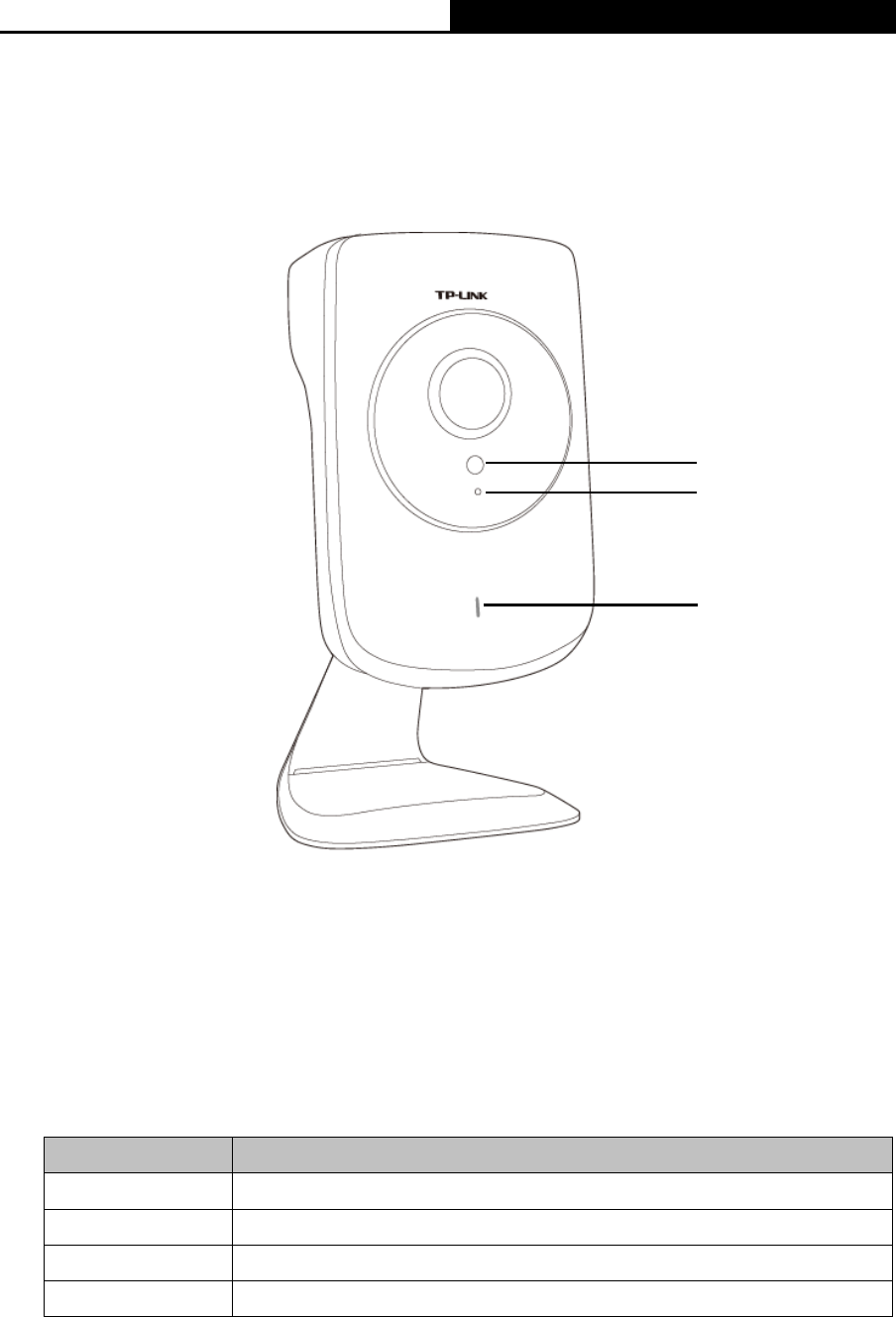
NC220
Day/Night Cloud Camera, 300Mbps Wi-Fi
2.3 Appearance Description
2.3.1 Front Panel
Figure 2-1 Front Panel
Light Sensor: The camera has a built-in internal photodetector. It is used to identify day or
night.
Microphone: The camera has a built-in internal microphone. This microphone is hidden in
the pinhole located on the front panel.
System LED:
Status Indication
Flashing Red The camera starts booting up.
Solid Red The camera has boot up, but is not connected to any network.
Flashing Green The camera is in firmware upgrade procedure.
Solid Green The camera is connected to a network or is transferring data.
System LED
Microphone
Light Sensor
3
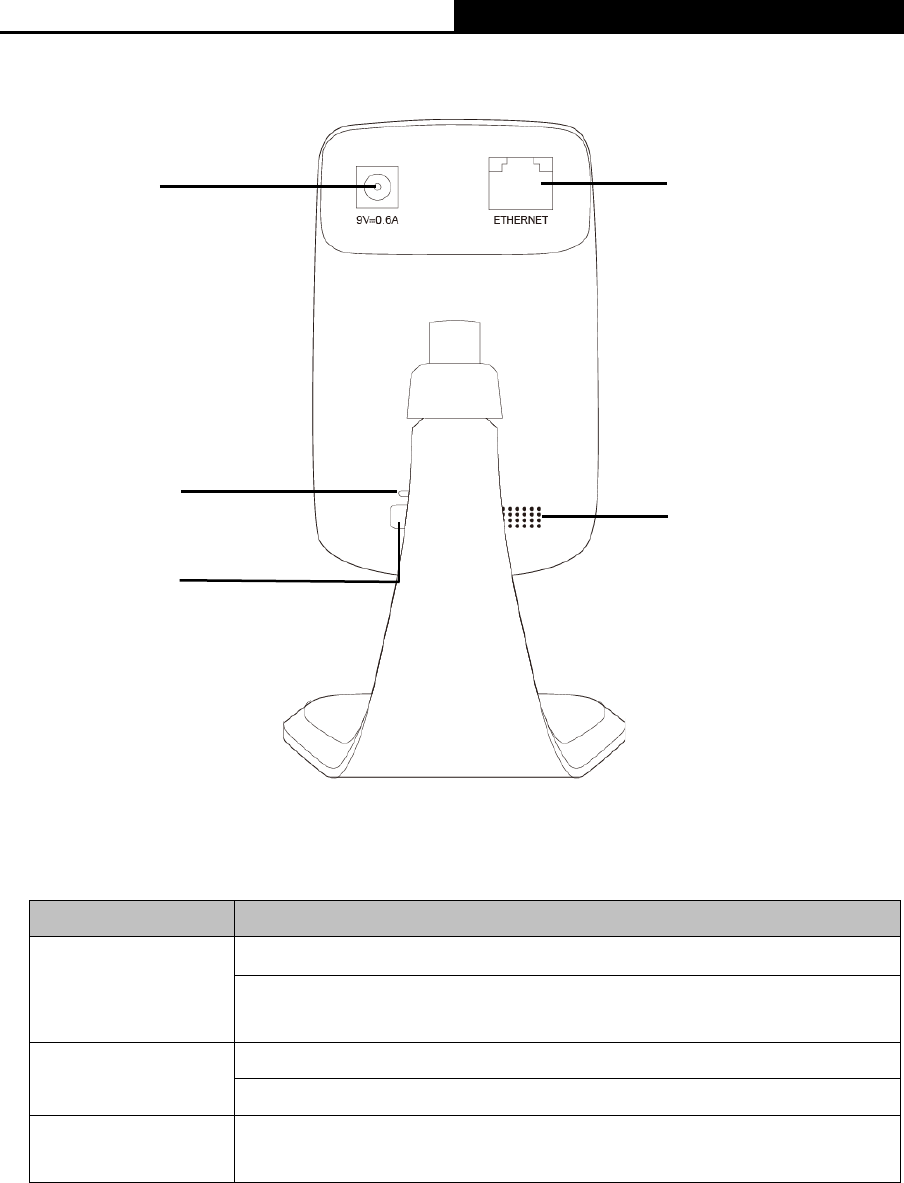
NC220
Day/Night Cloud Camera, 300Mbps Wi-Fi
2.3.2 Rear Panel
Figure 2-2 Rear Panel
WPS LED:
Status Indication
Flashing Green
The camera starts booting up.
The camera is connecting to a network by WPS function. This
process will last in the first 2 minutes.
Off The camera has boot up.
The camera failed to be added to a network by WPS function.
Solid Green The camera has been successfully added to a network by WPS
function. This process will last in the first 2 minutes.
ETHERNET Port: The ETHERNET port is used to connect the camera to a network via RJ45
cable.
Power Jack: The power jack is where you connect the AC adapter to the camera.
WPS/RESET Button: This button is used for both WPS and RESET function. To use the WPS
function, press it for 1 second; to use the RESET function, press and hold for more than 5
seconds.
ETHERNET Port
WPS LED
Power Jack
WPS/RESET
Button
Heat Emission Holes
4
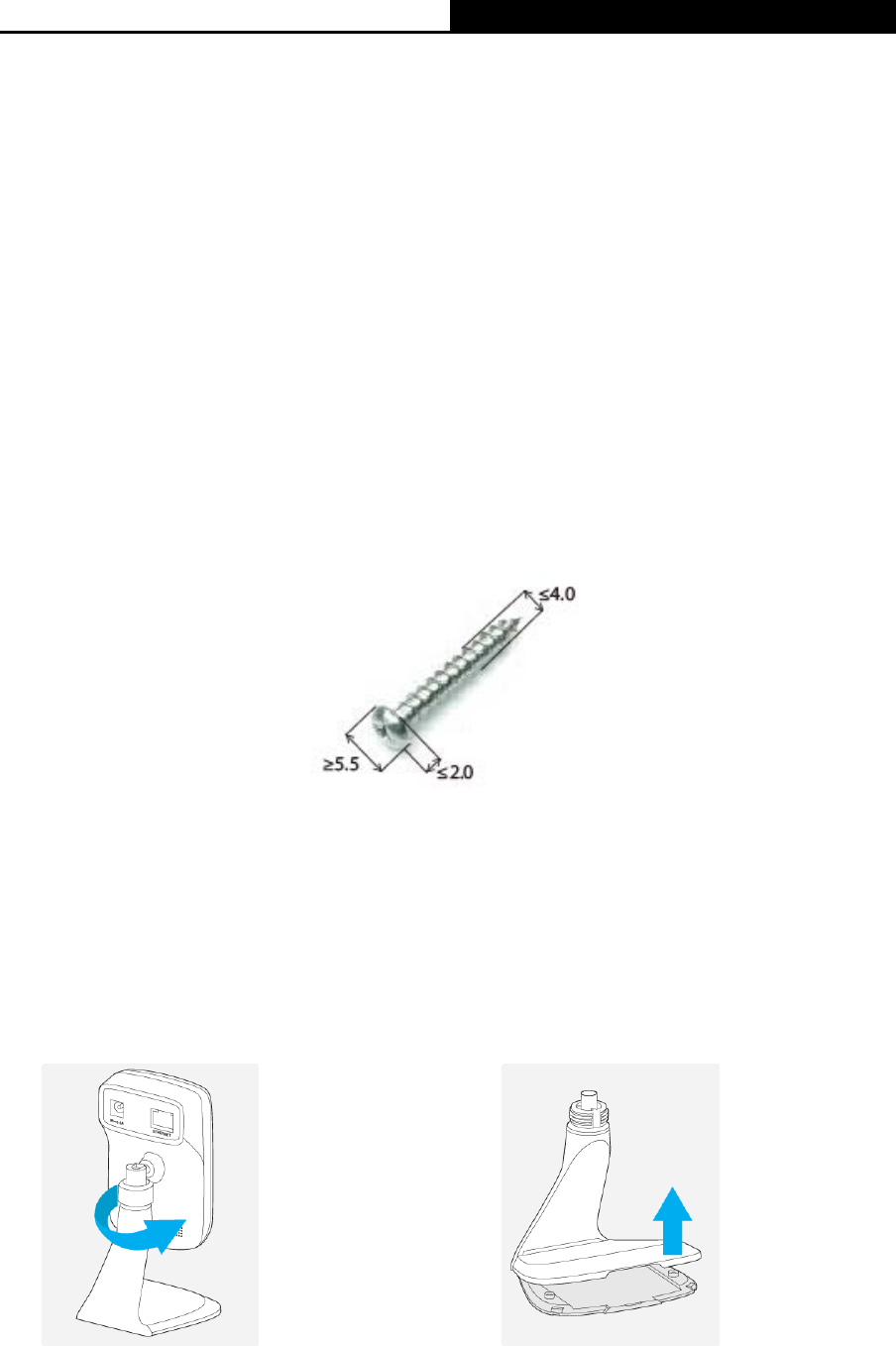
NC220
Day/Night Cloud Camera, 300Mbps Wi-Fi
Used as RESET button:
With the camera powered on, press and hold the WPS/RESET button (more than 5
seconds) until both the System LED and WPS LED turn off. Then release the button and
wait the camera to reset to its factory default settings.
Used as WPS button:
If your router supports WPS, then you can press the WPS/RESET button for 1 second to
quickly establish a connection between the camera and router.
Heat Emission Holes: These holes are used for heat dissipation.
2.4 Mount the Camera
2.4.1 The Screw Size
2.4.2 Mount the Camera
Note:
If you use the camera wirelessly, mount the camera within the coverage of your wireless network.
1. Unscrew the camera head.
2. Remove the base cover.
5
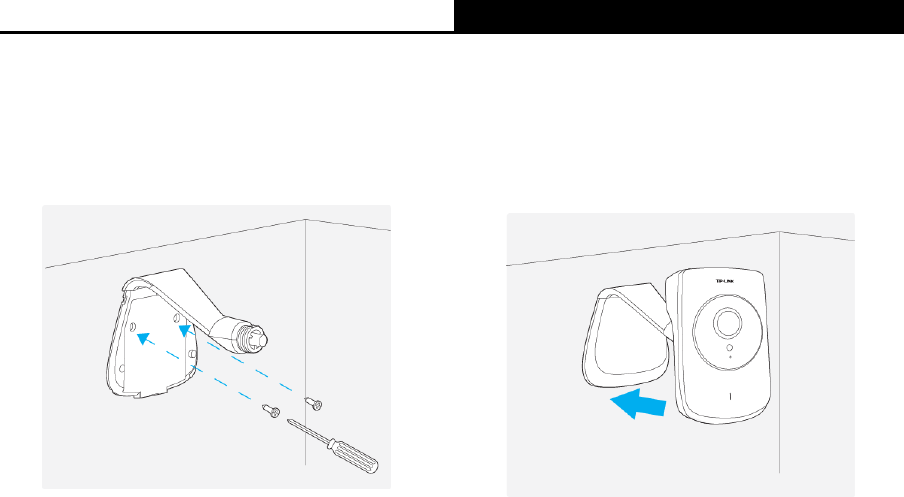
NC220
Day/Night Cloud Camera, 300Mbps Wi-Fi
3. Drill two mounting holes and fix the
mounting base.
4. Put the base cover and camera head back.
6
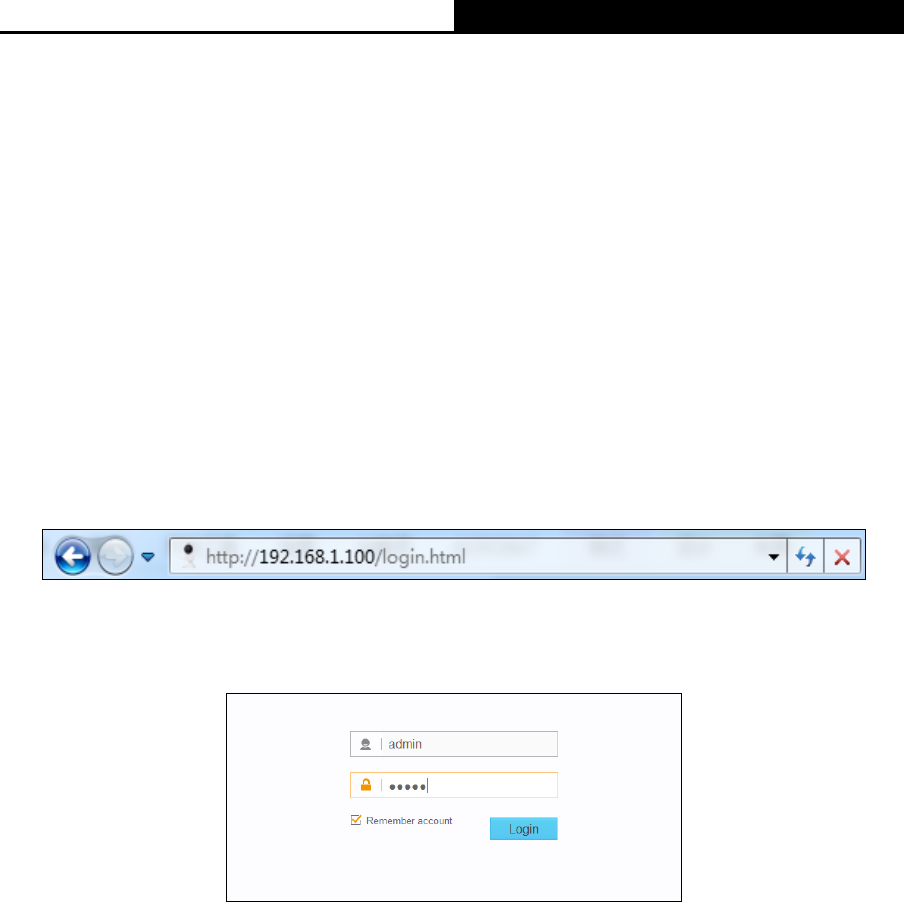
NC220
Day/Night Cloud Camera, 300Mbps Wi-Fi
Chapter 3 Managing the Camera
The camera’s built-in web management page is designed to allow you to easily access and
configure your camera.
3.1 Login
1. Find the management IP address of the camera in one of the following ways:
Run the Setup Wizard. The IP address is displayed on the Select a camera screen.
Find the IP address on the DHCP setting page of the front device such as router.
2. Open a Web browser and type in the management IP address in the address field of the
browser.
3. Enter the default username and password (admin/admin). Click Login to start the main
menu.
Note:
For the administrator, the default password is “admin”. We recommend that you change it in the
Account menu. (Go to “System → Account”)
If you log in to the camera as an administrator, you can perform all the settings provided by the
camera.
If you log in to the camera as a common user, you can only view the Live View. After logging as
administrator, you can add up to five user accounts in the Account menu. (Go to “System →
Account”)
4. Click Download to download and install the required plugin.
7
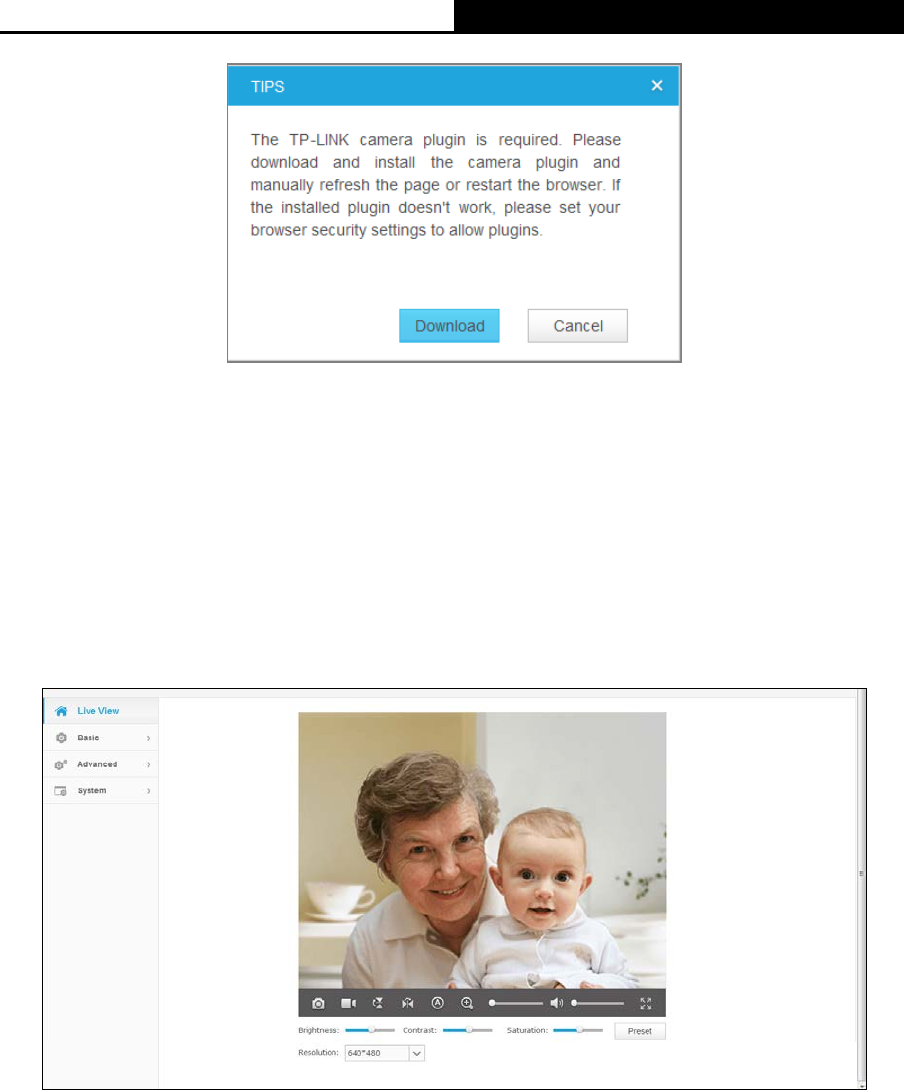
NC220
Day/Night Cloud Camera, 300Mbps Wi-Fi
Note:
If the installed plugin doesn't work, set your browser security settings to allow plugins. Here we
take the settings for IE browser as an example. Go to "Tools→Internet Options→Security". Click
"Internet→Custom Level", find the item "Download signed ActiveX controls" and check
Prompt. Click "Local Intranet→Custom Level", find the item "Download signed ActiveX
controls" and check Prompt.
5. After the plugin is successfully installed, refresh the webpage to display the monitor video.
3.2 Live View
The Live View screen shows you the live video feed from your camera. On this screen, you can
capture a picture, record a video, change the resolution and so on.
8
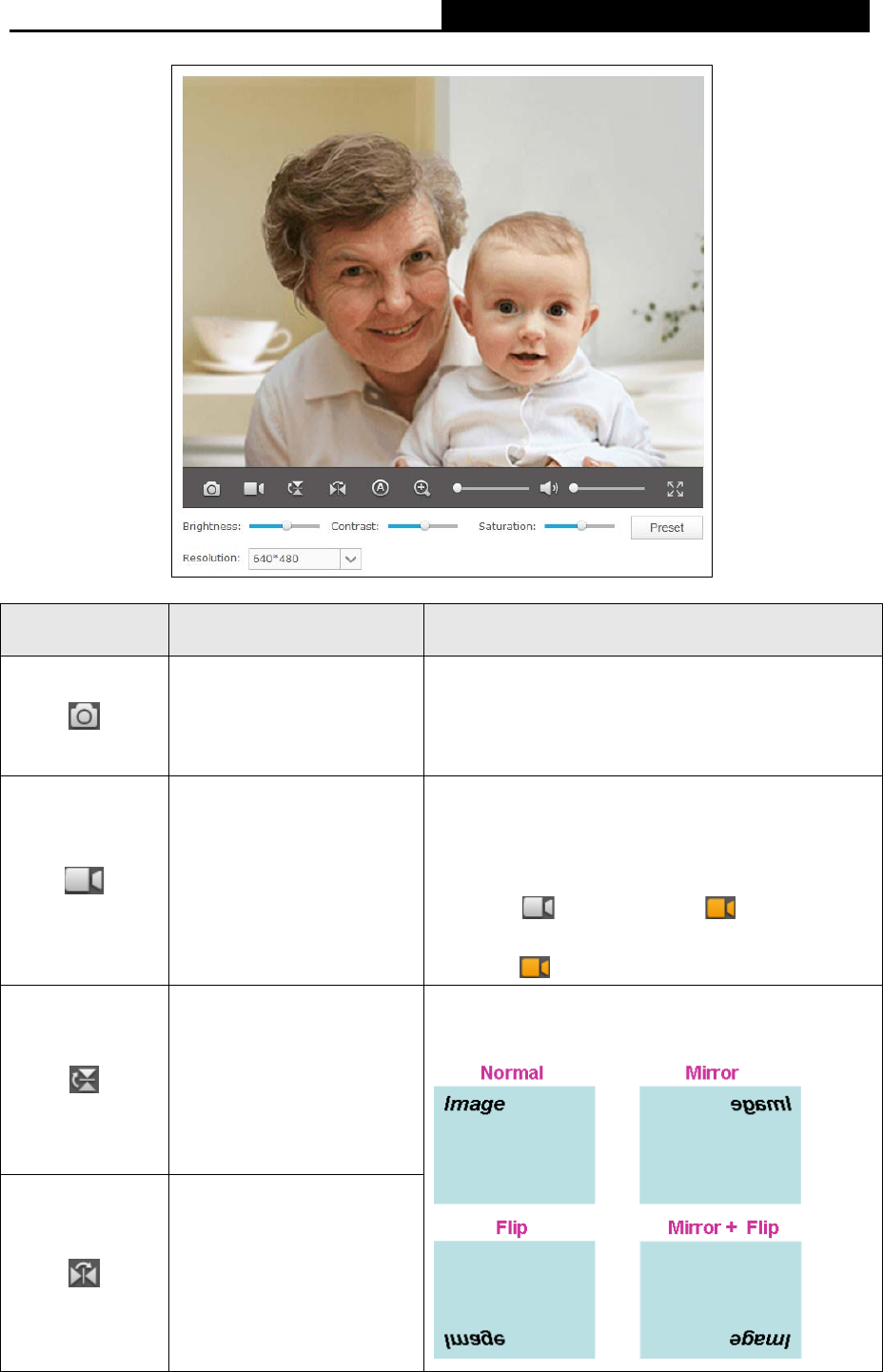
NC220
Day/Night Cloud Camera, 300Mbps Wi-Fi
Symbols Meaning Note
Click to
capture a still
image shot by the camera.
The image file will be saved in JPG
or BMP
format in your local computer. The file is named
as image-yyyy-mm-dd-hh-mm-ss.jpg. Y
ou can
select a save path and rename the image file.
Click to record the current
video.
The video file will be saved in
AVI format in your
local computer. The file is named as
rec-yyyy-mm-dd-hh-mm-
ssi.avi. You can select a
save path and rename the video file.
The icon will turn yellow once the save
path is selected. I
f you want to stop recording,
just click .
Click to vertically flip the
current image.
If the camera is installed upside down, Flip Image
and Mirror should both be checked.
Click to horizontally flip the
current image.
9
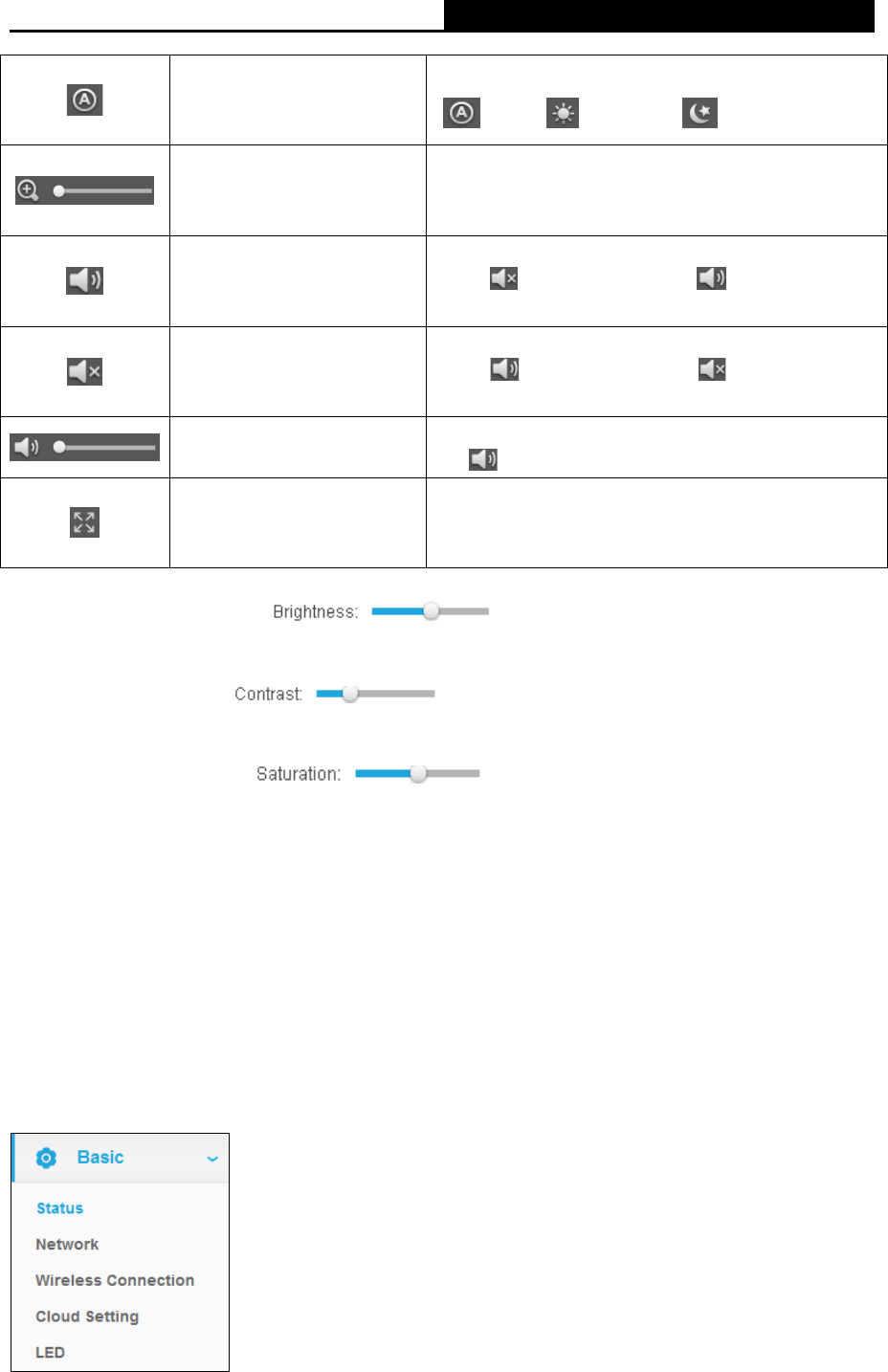
NC220
Day/Night Cloud Camera, 300Mbps Wi-Fi
Click to choose a camera
working mode.
You can set the camera working mode to Auto
(), Day ( ), or Night ( ).
Drag the slider to adjust
the size of the current
image.
The maximum zoom ratio is 4 times.
Mute off. You can hear the
curr
ent sound by the
camera.
Click and it will become .
Mute on. The current
sound by the camera is
turned off.
Click and it will become .
Drag the slider to adjust
the sound volume.
Y
ou can adjust the sound volume only with mute
off .
Click to enlarge the
current image
to full
screen display.
Press “ESC” key to return to the original screen
display.
Brightness: Drag the slider to adjust the brightness level of
camera. Large value will brighten the current displayed screen.
Contrast: Drag the slider to adjust the contrast level of the camera.
Large value will contrast the current displayed screen heavily.
Saturation: Drag the slider to adjust the saturation level of the
camera. Large value will saturate the current displayed screen to be more colorful.
Resolution: Select the desired video resolution between two formats: 640*480 and 320*240.
Higher setting offers better quality, but will require more bandwidth to stream.
Preset: Click the Preset button to restore to factory image settings.
3.3 Basic
Click the Basic menu to display the submenus including Status, Network, Wireless Connection,
Cloud Setting, and LED.
10
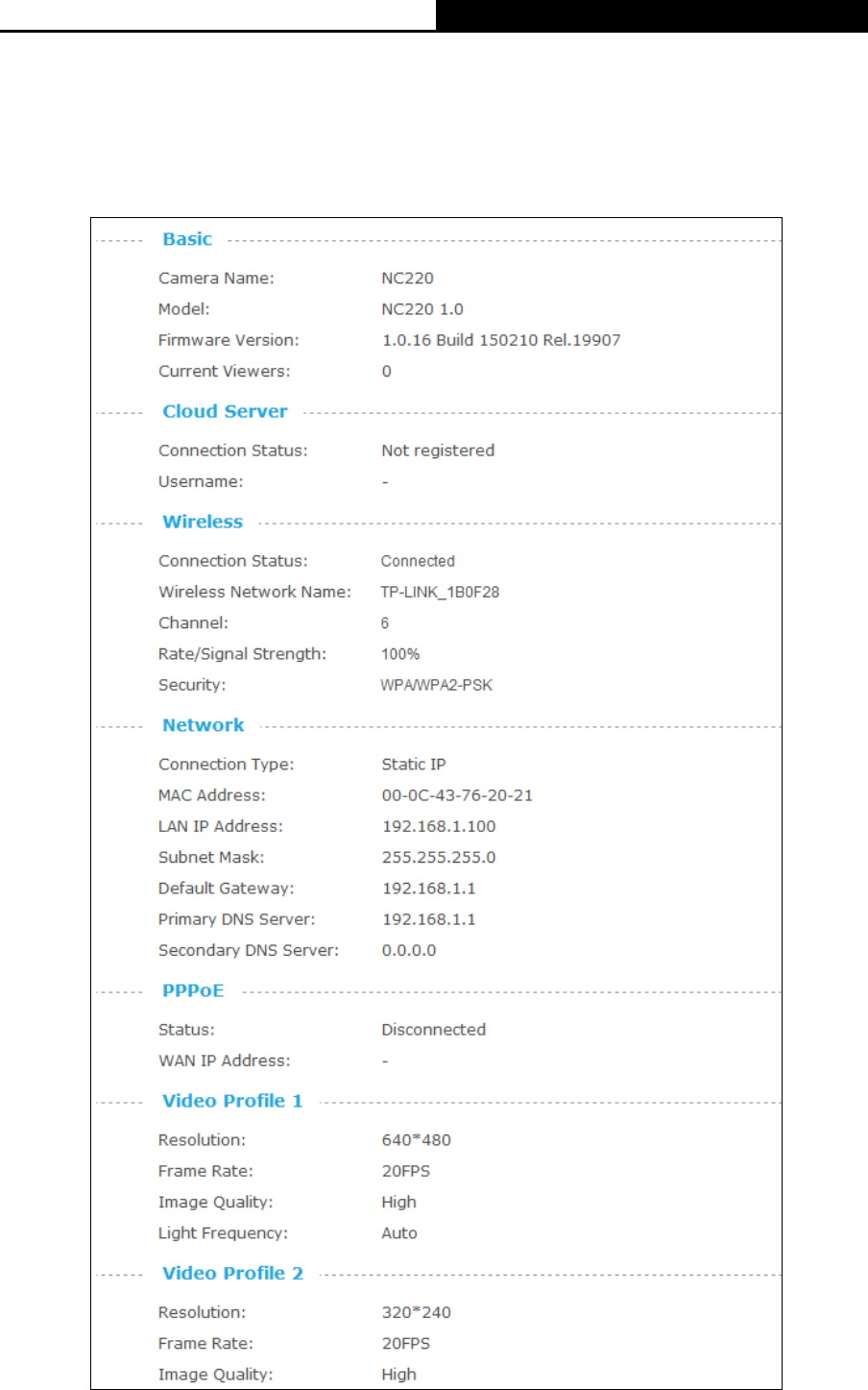
NC220
Day/Night Cloud Camera, 300Mbps Wi-Fi
3.3.1 Basic → Status
The Status page displays the current configuration information of the camera. You can find out
camera’s settings such as wireless connection settings here. All the information is read-only.
11
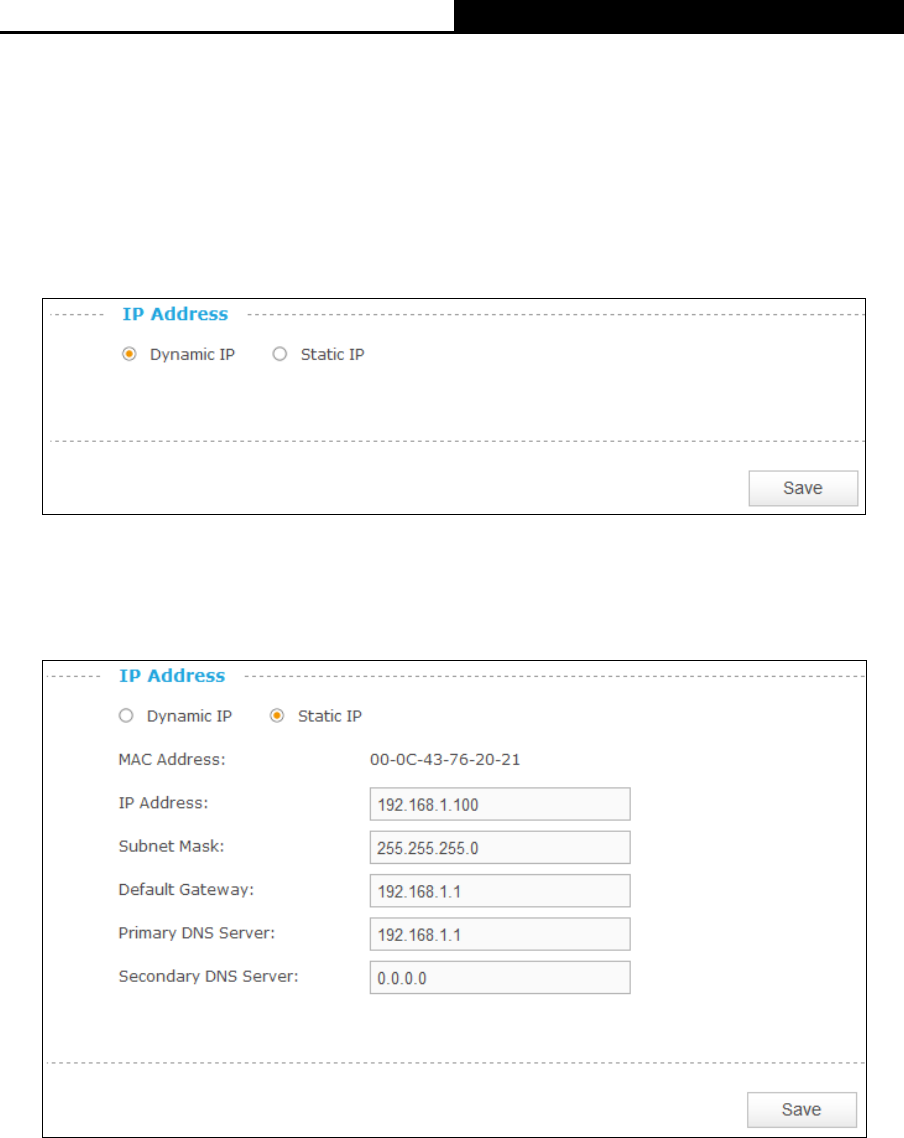
NC220
Day/Night Cloud Camera, 300Mbps Wi-Fi
3.3.2 Basic → Network
On this page, you can configure your camera’s IP address which is used to access and configure
the camera.
Dynamic IP: Select this option when a DHCP server is installed on the network to issue IP
address assignment. With this setting, the IP address of the camera is assigned automatically.
Static IP: Select this option when a static or fixed IP address is obtained for the camera. A
static IP address will ease your access to the camera in the future. Add your camera’s static
IP information to your router to avoid IP conflicts.
MAC Address: Displays the Ethernet MAC address of the camera. The MAC address is
read-only.
IP Address: Enter a fixed IP address for the camera in dotted-decimal notation.
Subnet Mask: Enter the subnet mask in dotted-decimal notation. The default value is
“255.255.255.0.”
Default Gateway: Enter the default gateway in dotted-decimal notation.
12
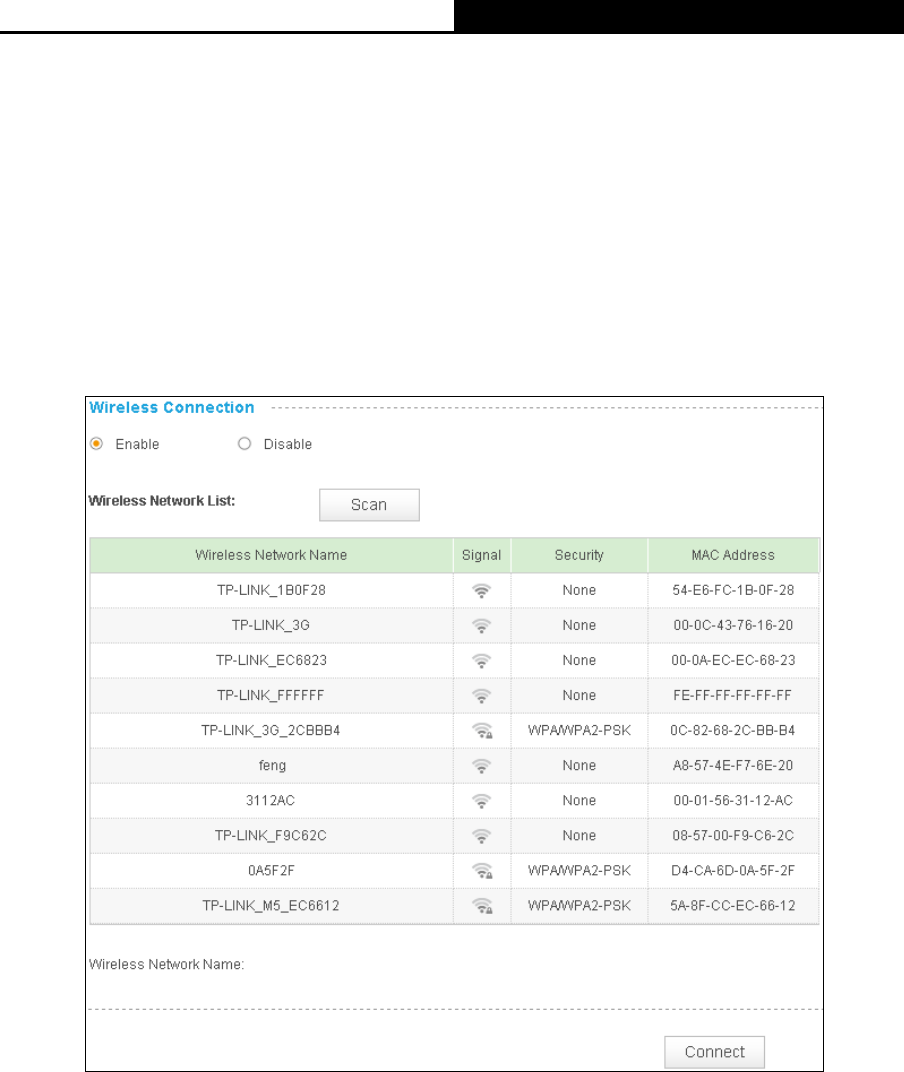
NC220
Day/Night Cloud Camera, 300Mbps Wi-Fi
Primary DNS Server: Enter a DNS address in dotted-decimal notation.
Secondary DNS Server: Enter a DNS address in dotted-decimal notation.
Click Save to save and enable the settings.
3.3.3 Basic → Wireless Connection
The camera’s wireless function is enabled by default. This function helps to connect your camera
to a wireless network wirelessly. If you don’t want to use this function, just select the Disable
option.
Wireless Network Name: Displays the wireless network’s name. Make sure the camera and
your PC connect to the same wireless network, or your PC can't access the camera.
Signal: Displays the strength of the wireless signal.
Security: Displays the wireless network’s security mode.
MAC Address: Displays the MAC address of the front device.
To connect your camera to a wireless network, follow the steps below:
1. Click Scan to scan the available wireless network and to refresh the Wireless Network List.
2. Select a wireless network from the wireless network list.
13
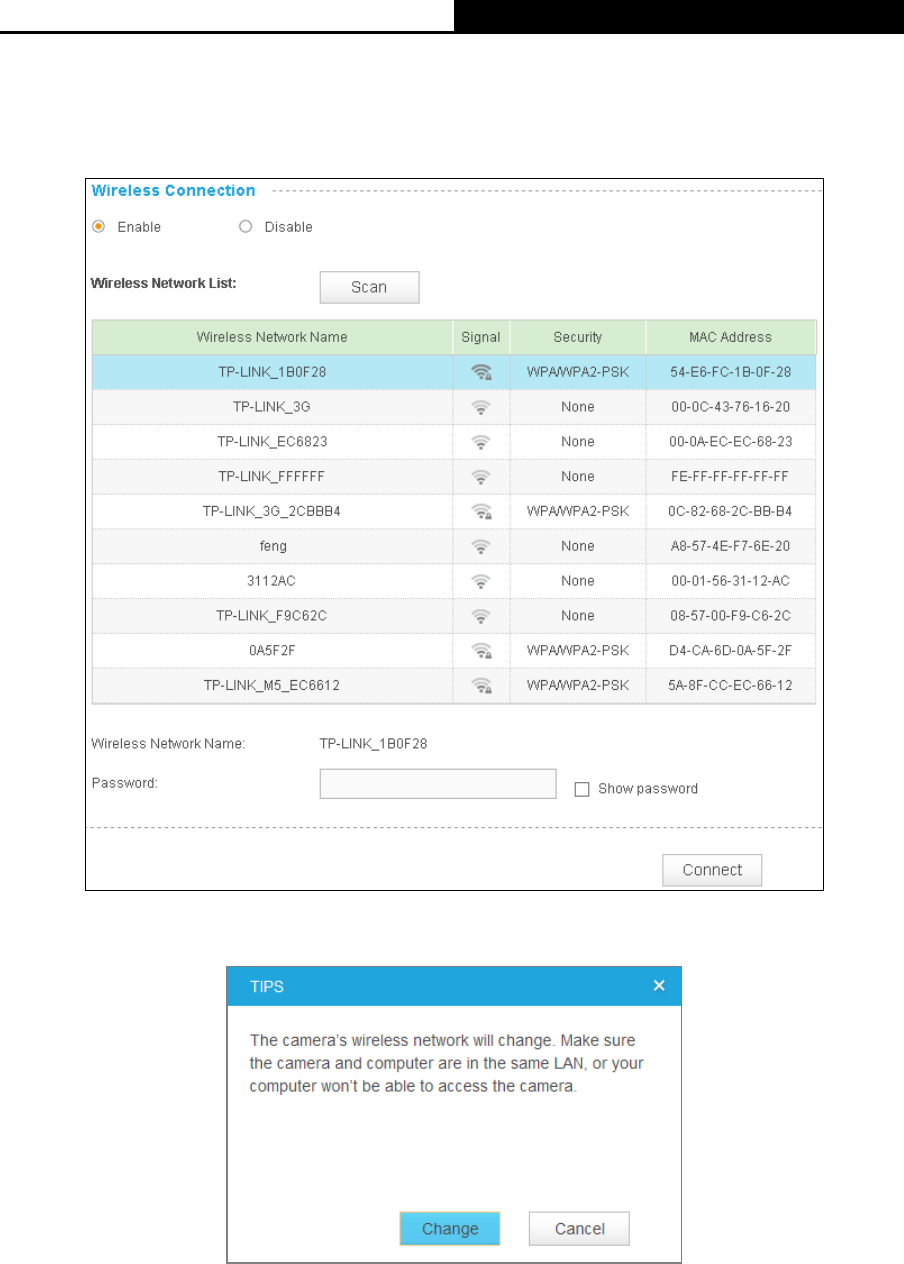
NC220
Day/Night Cloud Camera, 300Mbps Wi-Fi
3. If the wireless network’s security mode is None, simply click Connect. If the security mode is
one requiring for a password, enter the wireless network’s password and then click Connect.
You can select Show password to display what you’ve entered.
4. A pop-up screen will prompt you for the network modification. Click Change to continue.
5. Click OK on the pop–up screen to finish wireless connection procedure.
14
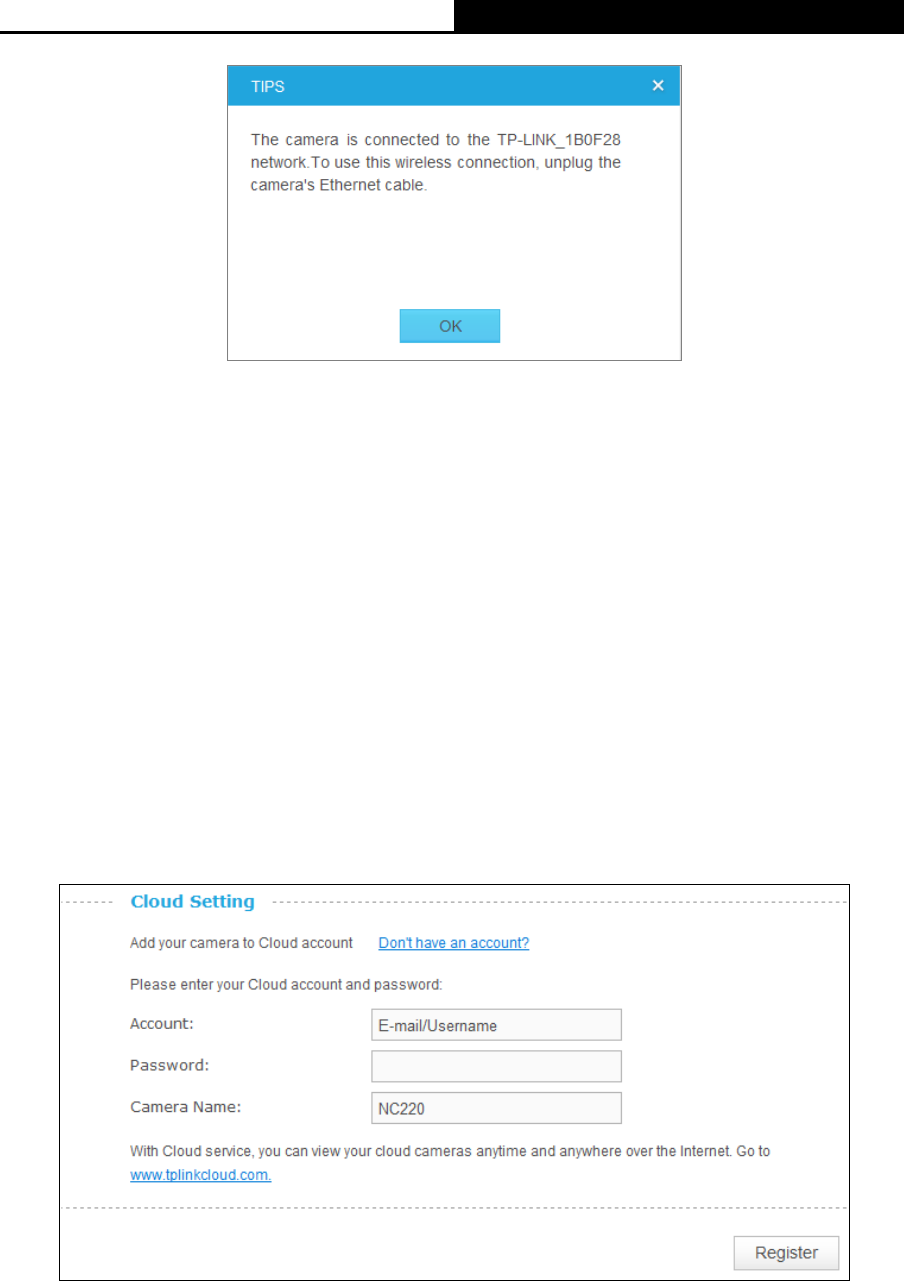
NC220
Day/Night Cloud Camera, 300Mbps Wi-Fi
6. To start using camera wirelessly, unplug its Ethernet cable.
3.3.4 Basic → Cloud Setting
A Cloud Camera can be viewed anytime and anywhere over the Internet with TP-LINK Cloud
service. On this page, you can add your camera to an existing TP-LINK Cloud account or you can
sign up for a TP-LINK Cloud account and then add your camera to it.
Note:
To add a camera to TP-LINK Cloud account or to sign up for a TP-LINK Cloud account, make sure
that the camera is connected to the Internet.
Add Your Camera to TP-LINK Cloud Account
If you already have a TP-LINK Cloud account, to add your camera to your account, just enter the
TP-LINK Cloud account and password, and then click Register.
Account: Enter your TP-LINK Cloud account, either E-mail address or username is allowed.
Password: Enter your TP-LINK Cloud account’s password.
Camera Name: The default value is the camera model. You can change it to an
15
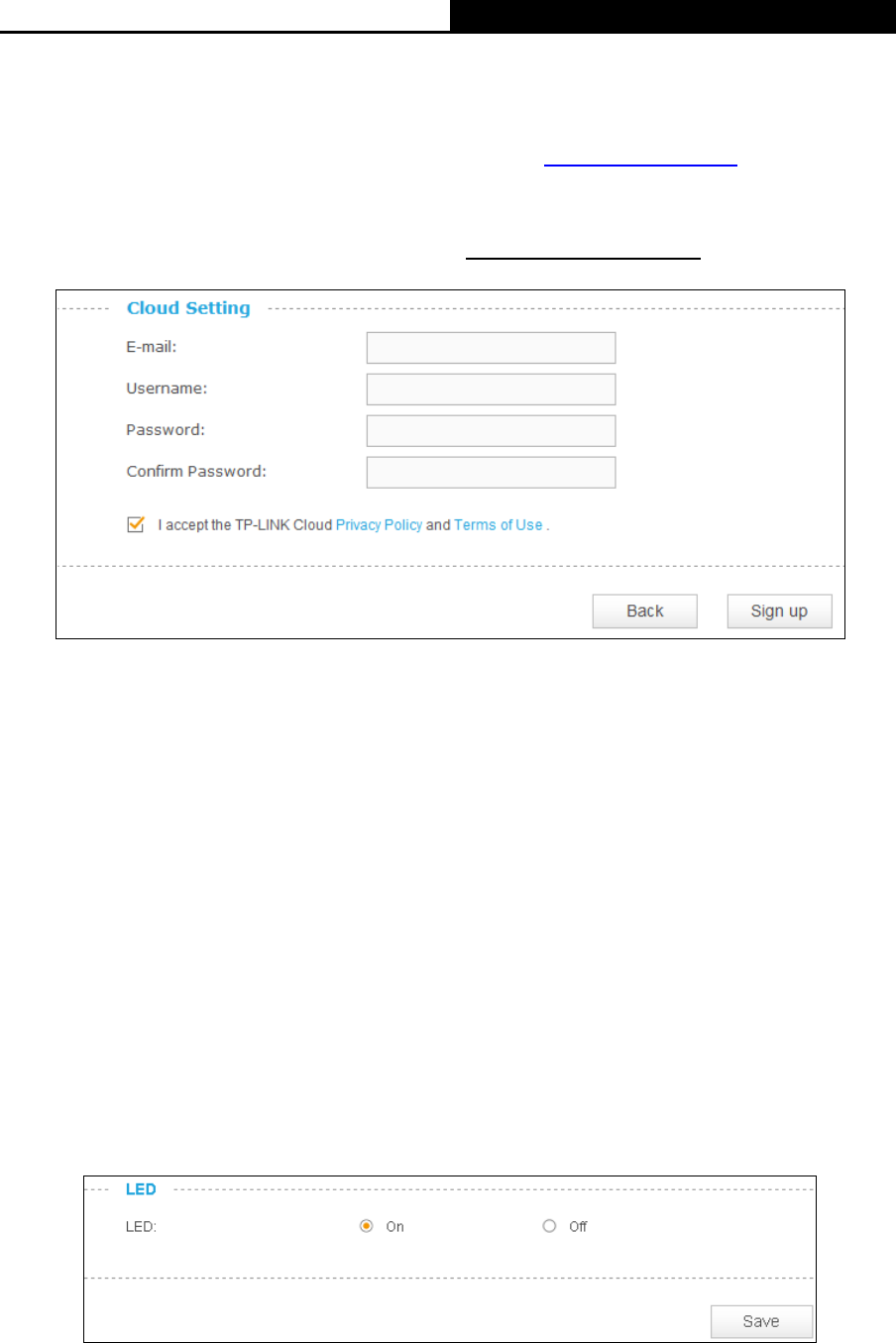
NC220
Day/Night Cloud Camera, 300Mbps Wi-Fi
easy-remember one. Camera name can contain up to 30 characters. It can only contain digits,
letters, space and .-_@'.
After your camera is registered successfully, you can go to www.tplinkcloud.com to view it.
Sign Up for a TP-LINK Cloud Account
If you do not have a TP-LINK Cloud account, click Don’t have an account? to sign up.
E-mail: Enter a valid E-mail address as your TP-LINK Cloud account. If you forget your
TP-LINK Cloud password, you can reset it via this E-mail address.
Username: Enter a username as your TP-LINK Cloud account. Username should contain
1-32 characters. It can only contain letters, digits and . - _.
Password: Enter a password for your TP-LINK Cloud account. Password should contain 6-20
characters. It can only contain letters, digits and .- _ ! @ # $,% ^& *.
Confirm Password: Enter the password again to confirm it.
Click Sign up to sign up for a TP-LINK Cloud account. After signing up successfully, you can add
your camera to this account. Click Back if you don’t want to sign up.
3.3.5 Basic → LED
The camera’s LED is on by default. If you want to turn it off, just select Off.
16
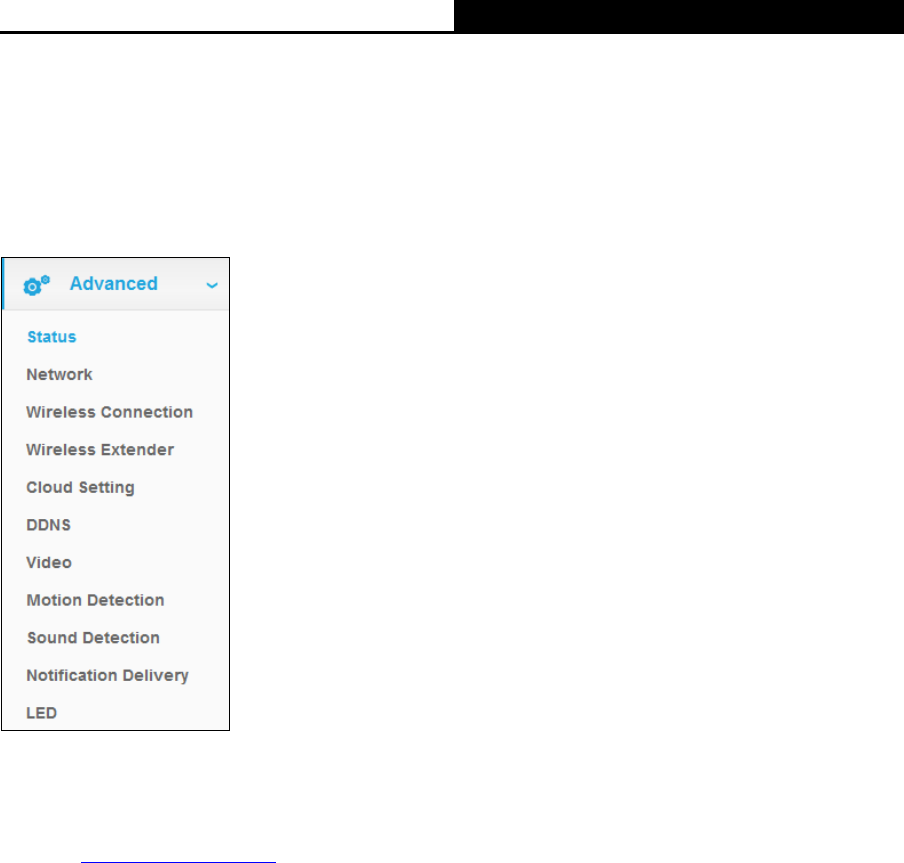
NC220
Day/Night Cloud Camera, 300Mbps Wi-Fi
3.4 Advanced
Click the Advanced menu to display the submenus including Status, Network, Wireless
Connection, Wireless Extender, Cloud Setting, DDNS, Video, Motion Detection, Sound
Detection, Notification Delivery, and LED.
3.4.1 Advanced → Status
Refer to 3.3.1 Basic → Status.
3.4.2 Advanced → Network
On this page, you can configure your network settings.
17
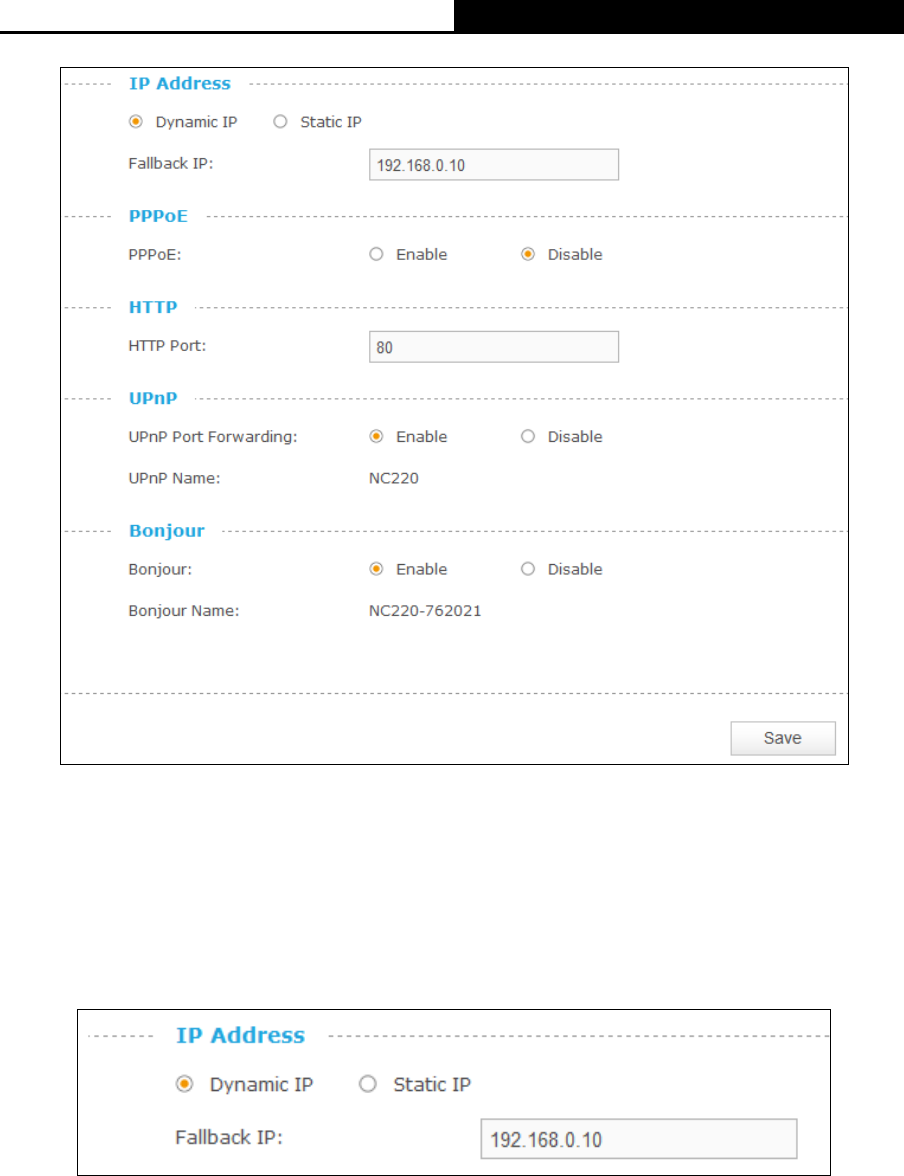
NC220
Day/Night Cloud Camera, 300Mbps Wi-Fi
IP Address
On this section, you can configure your camera’s IP address which is used to access and
configure the camera.
Dynamic IP: Select this option when a DHCP server is installed on the network to issue IP
address assignment. With this setting, the IP address of the camera is assigned automatically.
Fallback IP: If the camera cannot get a Dynamic IP address from a DHCP server within
limited tries, the camera will assign a default IP address, 192.168.0.10, by itself as the
Fallback IP address.
Static IP: Select this option when a static or fixed IP address is obtained for the camera. A
static IP address will ease your access to the camera in the future. Add your camera’s static
IP information to your router to avoid IP conflicts.
18
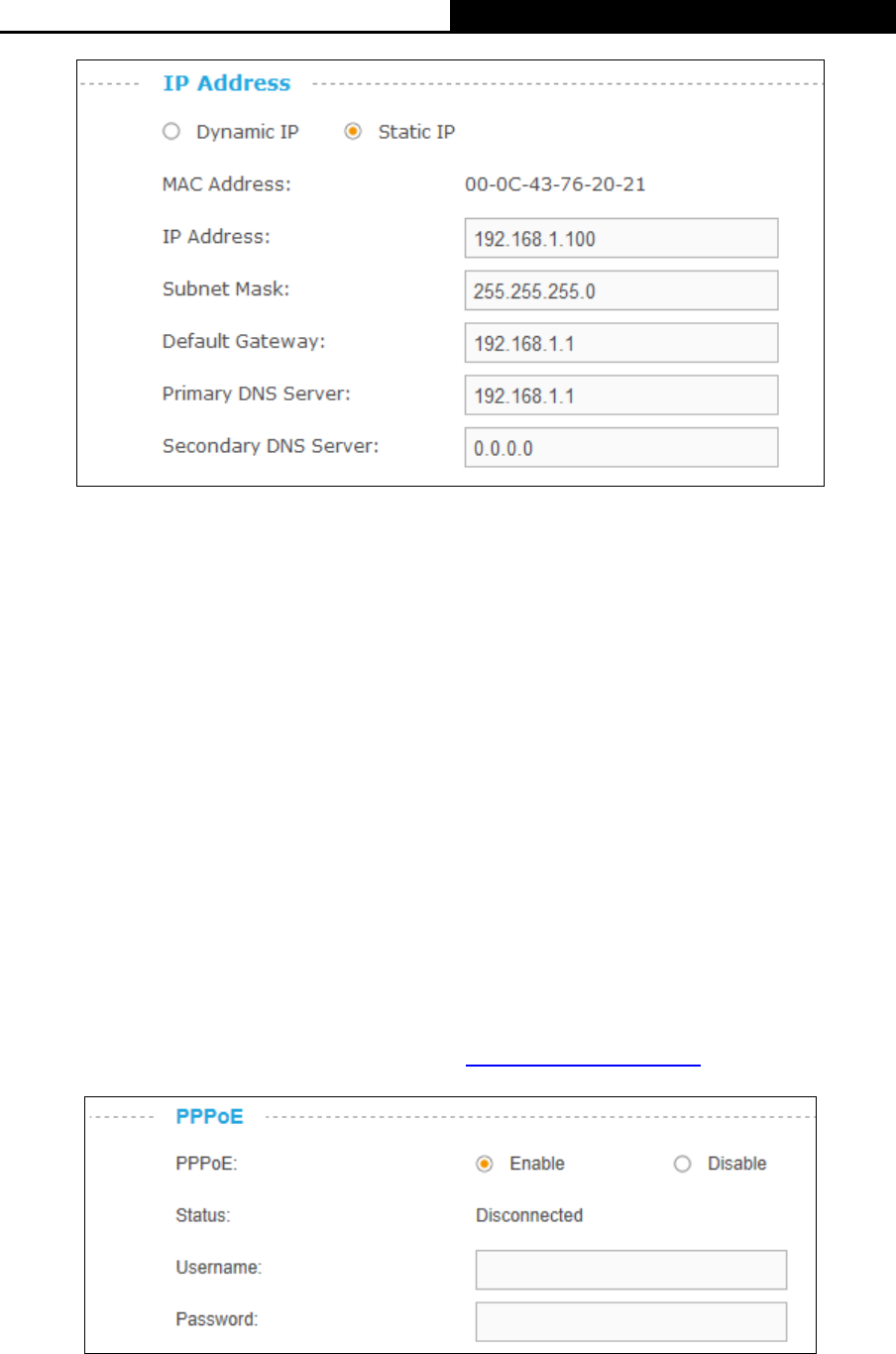
NC220
Day/Night Cloud Camera, 300Mbps Wi-Fi
MAC Address: Displays the Ethernet MAC address of the camera. The MAC address is
read-only.
IP Address: Enter a fixed IP address for the camera in dotted-decimal notation.
Subnet Mask: Enter the subnet mask in dotted-decimal notation. The default value is
“255.255.255.0.”
Default Gateway: Enter the default gateway in dotted-decimal notation.
Primary DNS Server: Enter a DNS address in dotted-decimal notation.
Secondary DNS Server: Enter a DNS address in dotted-decimal notation.
PPPoE (Point to Point Protocol over Ethernet)
This camera is a PPPoE enabled one. It can directly connect to the xDSL, however, it should be
set up in a LAN environment to configure the PPPoE information first, and then connect to the
xDSL modem. Power on again, and the camera will dial on to the ISP to get a dynamic IP address
and connect to the WAN through the xDSL modem. In this case, you need to use a domain name
to log in to the camera. For details, please refer to 3.4.6 Advanced → DDNS.
PPPoE: To enable or disable the PPPoE service here.
19
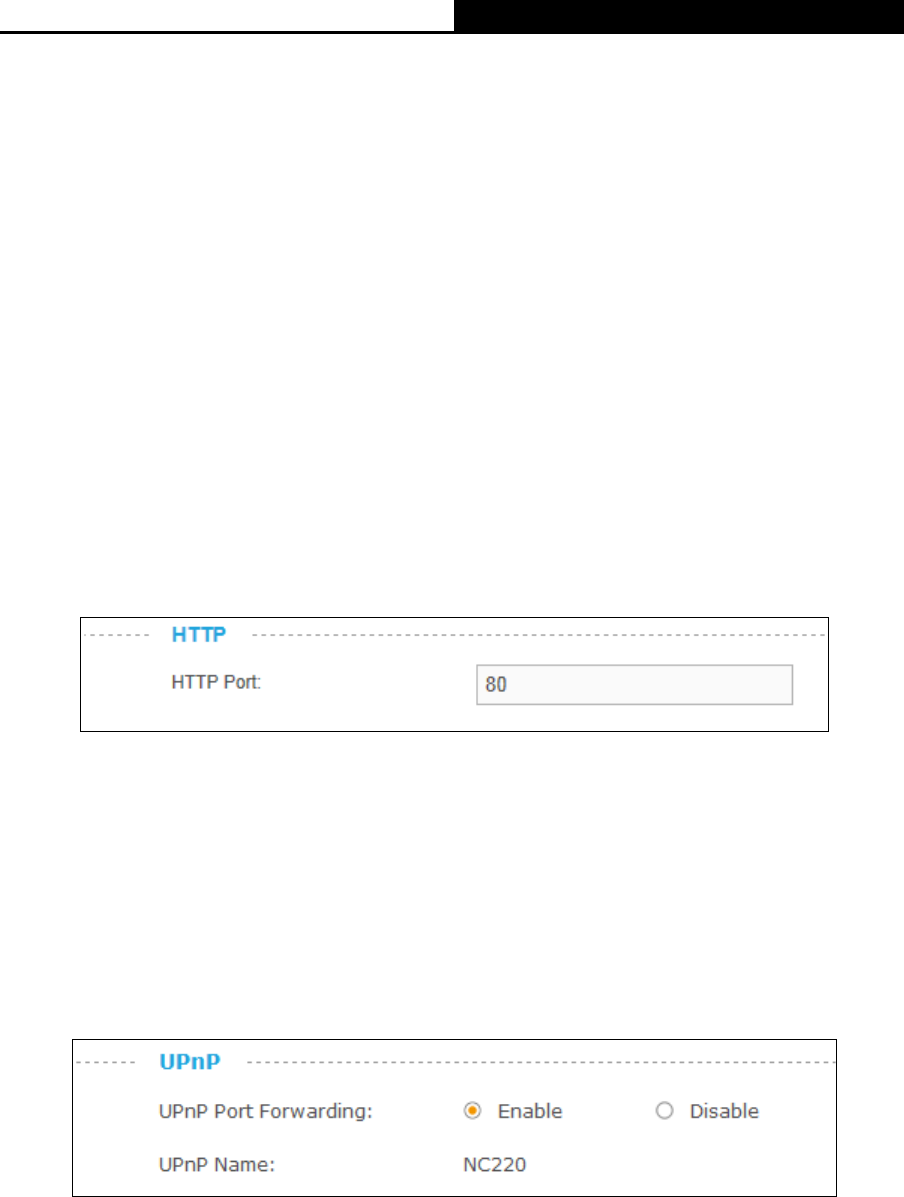
NC220
Day/Night Cloud Camera, 300Mbps Wi-Fi
Status: Displays the PPPoE connection status.
Username: Enter the username for PPPoE service provided by your ISP.
Password: Enter the password for PPPoE service provided by your ISP.
HTTP (Hypertext Transfer Protocol)
This feature allows you to access and manage your camera from a remote location over the
Internet. Web browser access normally uses the standard HTTP service port 80. This camera's
default remote management web port number is 80. For greater security, you can change the port
to a custom one.
When you have set the HTTP port number to a number other than 80, a corresponding port must
be opened on the router.
Access the camera by typing the IP address of the camera on the Web browser as follows: for
example, when HTTP port number is set to 2000 and the IP address of your camera is set to
192.168.1.100, you should type in http://192.168.1.100:2000 instead of http://192.168.1.100 to
access the camera.
HTTP Port: The default value is 80. If you want to use a port number other than 80, enter a
port number between 1 and 65535.
UPnP (Universal Plug and Play)
This camera is an UPnP enabled one. This means the camera can dynamically join a network,
obtain an IP address. In turn, the camera can leave a network smoothly and automatically when it
is no longer in use. UPnP is enabled by default; if you don’t want to use this function, just select
the Disable option.
UPnP Port Forwarding: To enable or disable the UPnP Port Forwarding service here. If this
function is enabled and your router supports U PnP, the cameras and router can communicate
with each other so that the router knows which ports are used by which camera.
UPnP Name: Displays the camera name.
20
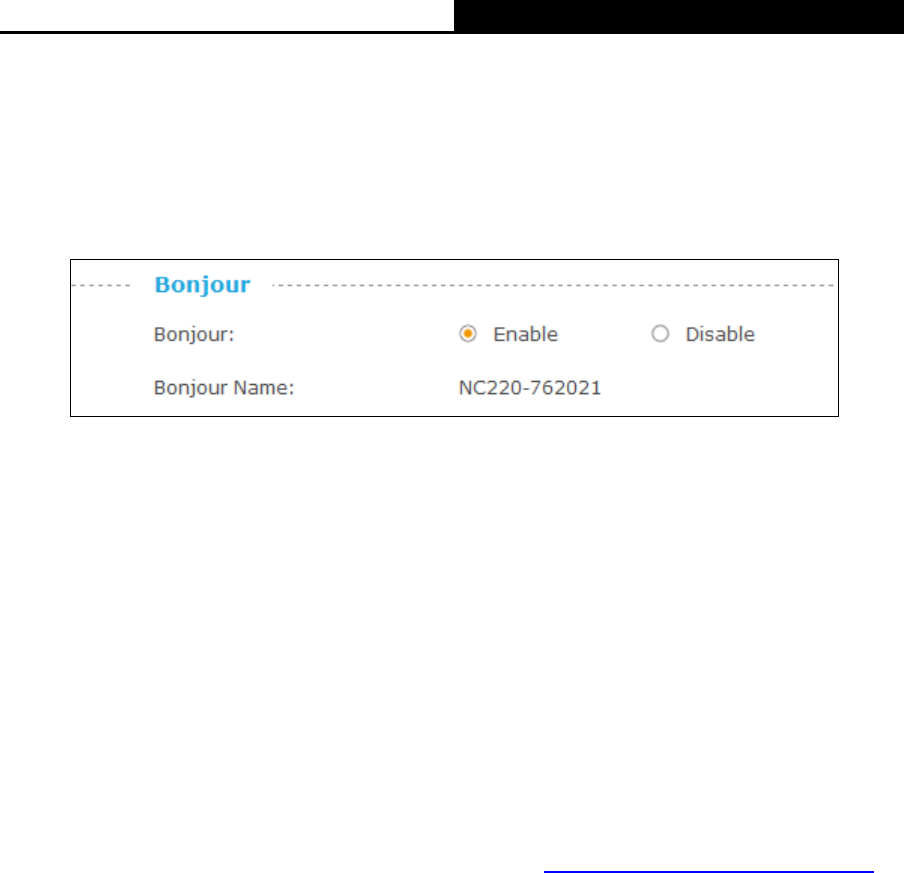
NC220
Day/Night Cloud Camera, 300Mbps Wi-Fi
Bonjour
Bonjour, also known as zero-configuration networking, enables automatic discovery of computers,
devices, and services on IP networks. Bonjour uses industry standard IP protocols to allow
devices to automatically discover each other without the need to enter IP addresses or configure
DNS servers.
Bonjour: To enable or disable the Bonjour service here.
Bonjour Name: Displays the Bonjour name. By default, it is a combination of model and the
last six characters of the camera’s MAC address.
Click Save to save and enable the settings.
3.4.3 Advanced → Wireless Connection
The camera’s wireless function is enabled by default. With this function enabled, you can connect
your camera to a wireless network wirelessly. If you don’t want to use this function, just select the
Disable option.
On this page, you can either scan a wireless network to connect to or enter a wireless network’s
parameters manually. To scan a wireless network, refer to 3.3.3 Basic → Wireless Connection. To
enter the parameters manually, see the following.
21
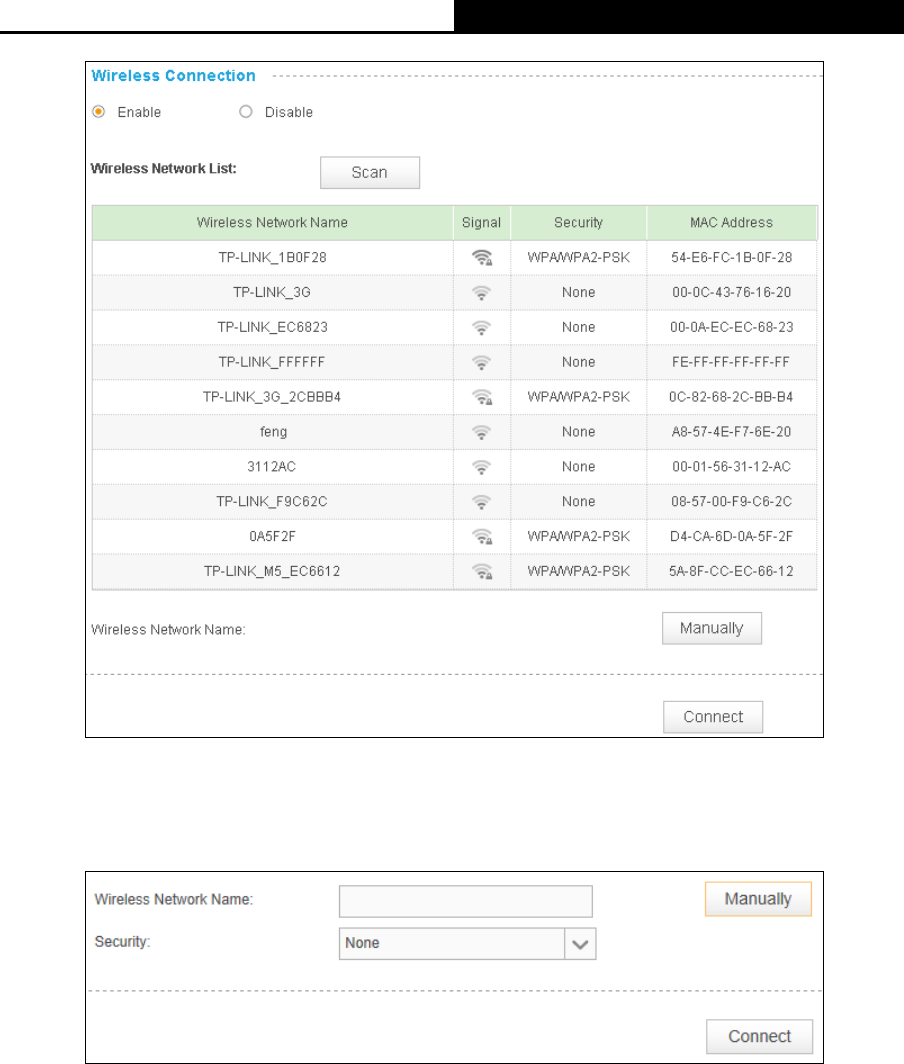
NC220
Day/Night Cloud Camera, 300Mbps Wi-Fi
1. Select Enable to enable your camera’s wireless function.
2. Click Manually, and you will see the following screen.
3. In the Wireless Network Name field, enter the name of the wireless network to which your
camera is ready to connect.
Note:
The name must be exactly the same as that used in the wireless access point, or the connection
will not be established. Leaving this field blank means the camera will attempt to access the
nearest open network. If your PC wants to access the camera, make sure your PC and the camera
are connecting to the same wireless network.
4. Select the wireless security mode used by your wireless network from the drop-down list. The
security mode and its corresponding settings must be exactly the same as that used in the
wireless network.
22
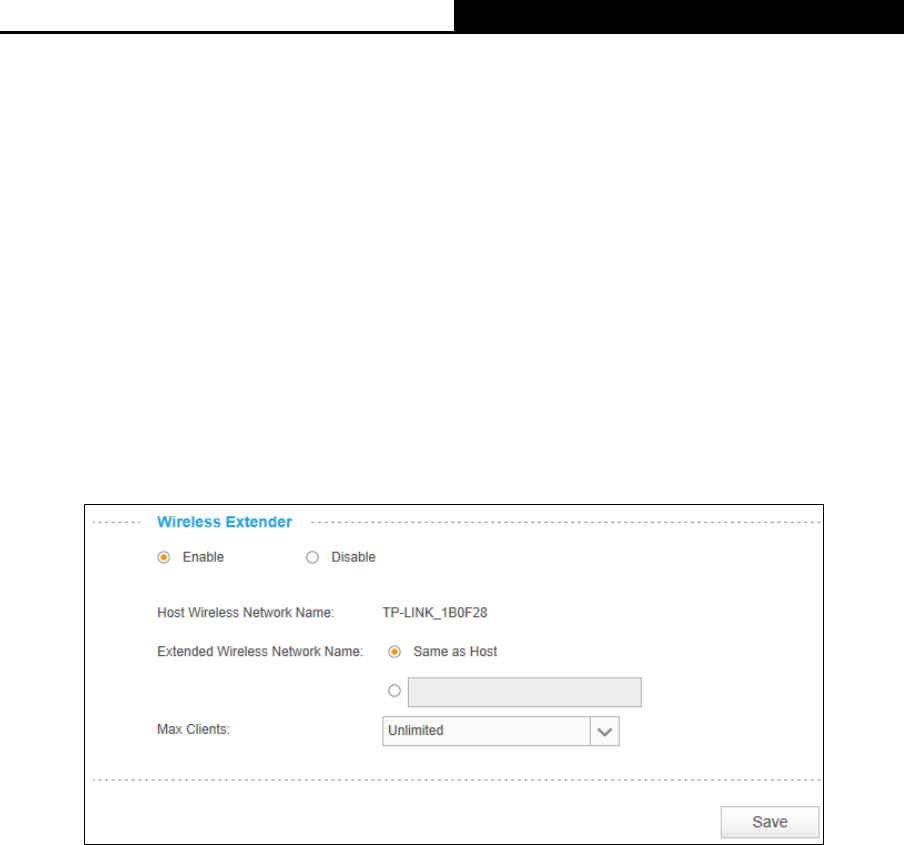
NC220
Day/Night Cloud Camera, 300Mbps Wi-Fi
5. Click Connect and a screen will pop up. Click Change on the pop-up screen.
6. Click OK on the pop–up screen to finish wireless connection procedure.
7. To start using camera wirelessly, unplug its Ethernet cable.
3.4.4 Advanced → Wireless Extender
On this page, you can setup and configure the wireless network extending feature of your camera.
Wireless extender function allows your camera to extend the range of your existing wireless
network. The same network name and settings as the existing wireless network can be used, or
you can create a new one.
The camera’s wireless extender function is disabled by default. If you want to use this function, just
select the Enable option.
Host Wireless Network Name: Displays the name of the wireless network which your
camera is connected to. It is read-only.
Extended Wireless Network Name: Name of the wireless network that your camera will
extend.
Same as Host: The extended network will use the same name and settings as your Host
network. Your devices can use the same wireless information to connect to both the host
and extended networks.
Create a New One: Select this to manually set the name and security used for the
extended network. You devices can use the wireless parameters you set to connect to the
extended network.
23
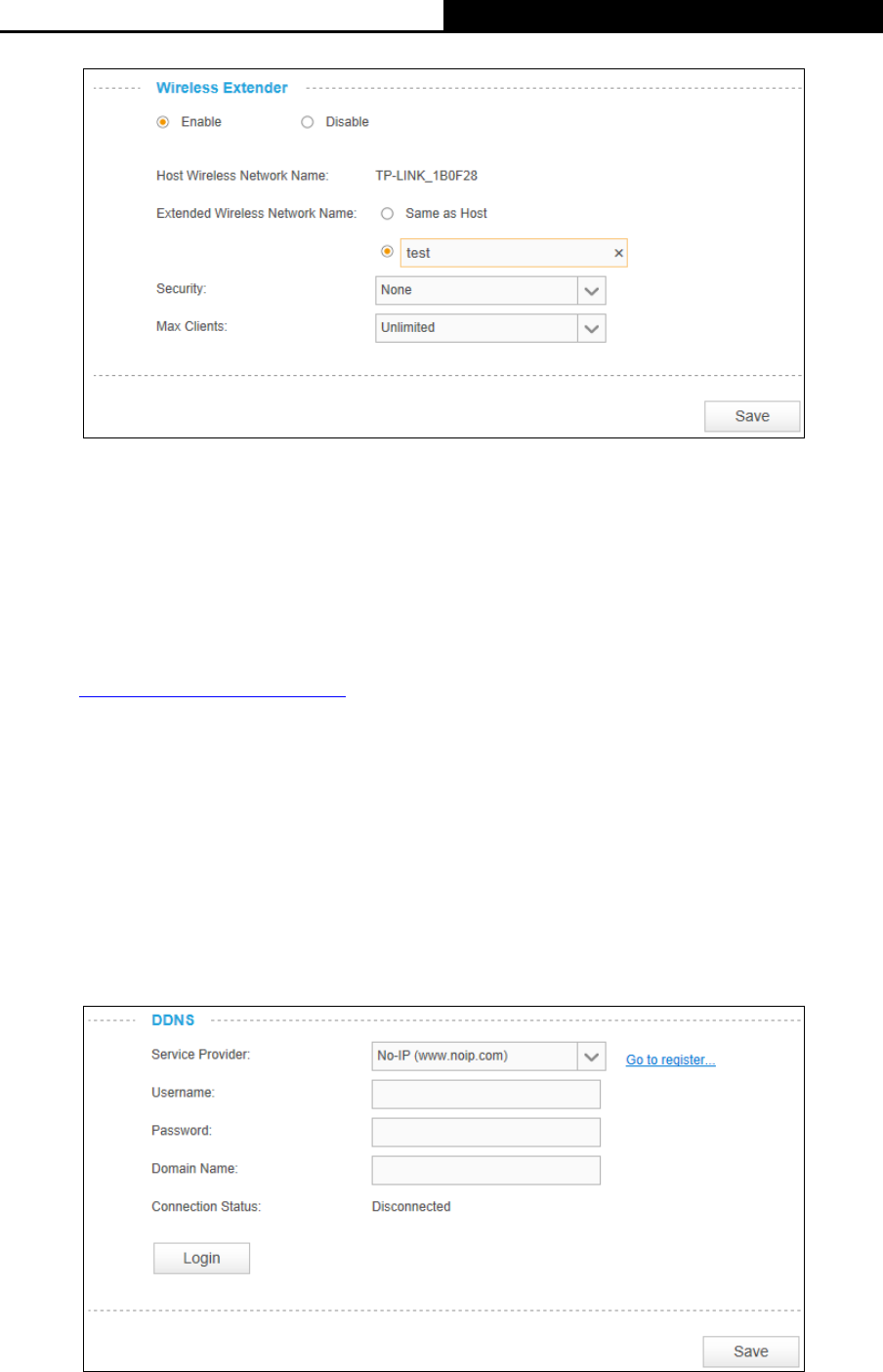
NC220
Day/Night Cloud Camera, 300Mbps Wi-Fi
Max Clients: Set the maximum number of clients that are allowed to connect to the extended
network.
Click Save to save and enable the settings.
3.4.5 Advanced → Cloud Setting
Refer to 3.3.4 Basic → Cloud Setting.
3.4.6 Advanced → DDNS
If your camera is connected to xDSL modem or cable modem directly, you might need this feature
on the camera to allow you and your friends have access to the camera using domain name, in no
need of remembering the IP address. However, if your camera is behind a NAT router, you need to
set DDNS on your router, in no need of setting this on the camera. As to xDSL environment, most
users will use dynamic IP addresses. If users want to set up a web or a FTP server, then the
DDNS (Dynamic Domain Name Server) is necessary.
24
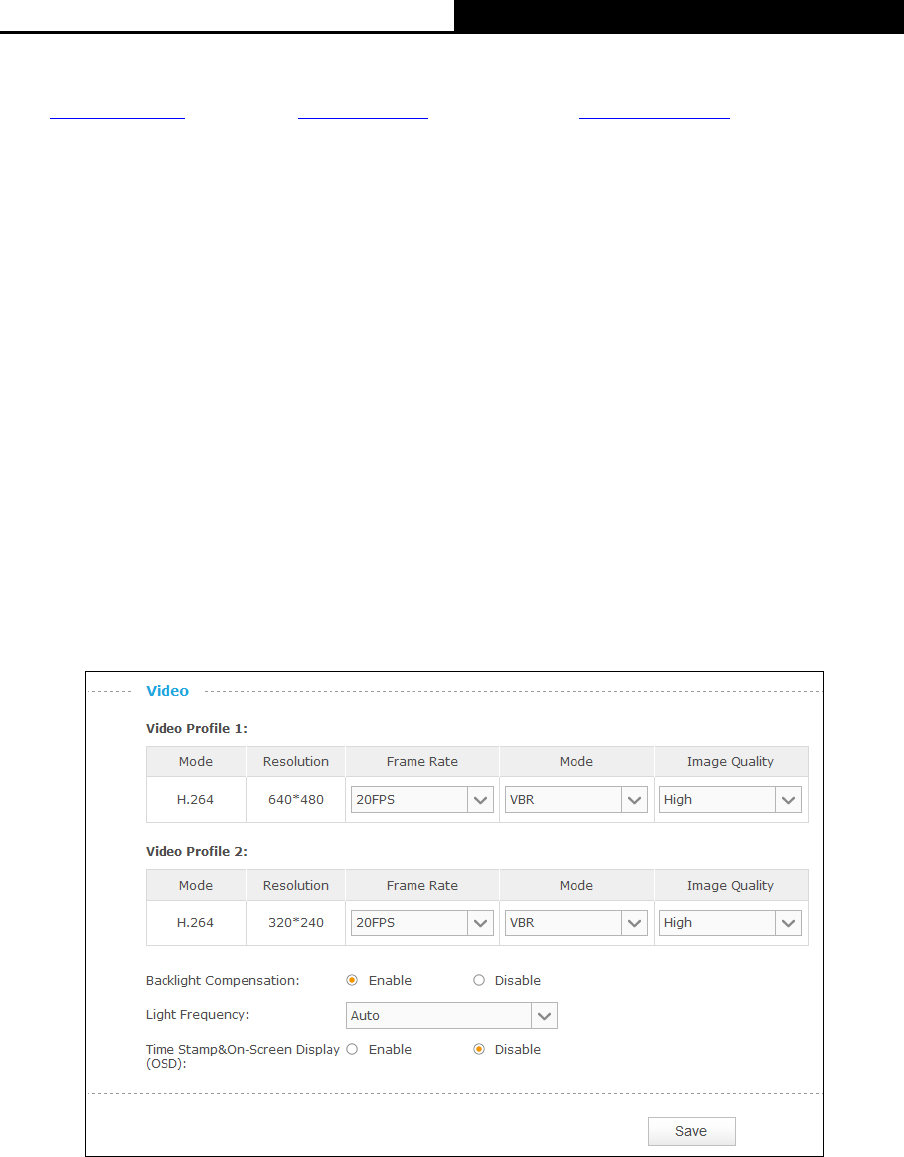
NC220
Day/Night Cloud Camera, 300Mbps Wi-Fi
Service Provider: Select one of the built-in DDNS servers from the drop-down list: No-IP
(www.noip.com), DynDNS (www.dyn.com), and Comexe (www.comexe.cn).
Note:
If you have not registered for any of the listed DDNS servers, please select one and click Go to
register… and follow the instructions provided on the official website to register.
Username: Enter the username that is used to log into DDNS.
Password: Enter the password that is used to log into DDNS.
Domain Name: Enter the domain name that is applied to your camera and used to access
your camera.
Connection Status: Displays the current status of DDNS connection.
Click Login. After logging in successfully, click Save to save and enable the settings.
3.4.7 Advanced → Video
On this page, you can configure the video settings for your camera.
This camera provides two video profiles: Video Profile 1 for local viewing and Video Profile 2 for
remote viewing.
Mode: Displays the coding format of the camera.
Resolution: Displays the video resolution of the camera, which is 640*480 for Video Profile 1
and 320*240 for Video Profile 2. Higher resolution offers better quality, but will require more
bandwidth to stream.
Frame Rate: Select the frame rate to use for the video stream from the drop-down list. Higher
25

NC220
Day/Night Cloud Camera, 300Mbps Wi-Fi
settings offer better quality, but will require more bandwidth to stream.
Mode: Select the bit rate mode of the camera. It can be VBR (variable bit rate) or CBR
(constant bit rate).
Image Quality: Select one of the three levels of image quality from the drop-down list: High,
Medium, and Low. Higher settings offer better quality, but will require more bandwidth to
stream.
Backlight Compensation: If enabled, this feature will compensate for bright backgrounds so
foreground objects aren't silhouetted. It is enabled by default.
Enabled
Disabled
Light Frequency: Select the frequency used by your lighting and power to help reduce image
flicker. The default setting is auto, which is recommended.
Time Stamp&On-Screen Display (OSD): If enabled, the current time of your camera, which
can be set on the System → Date/Time page, will be displayed on the Live View screen.
Meanwhile, you can set the OSD text to be displayed with the time stamp. The OSD text is
camera name by default.
Enabled
Disabled
2015-03-10 09:51:21
NCC220
26
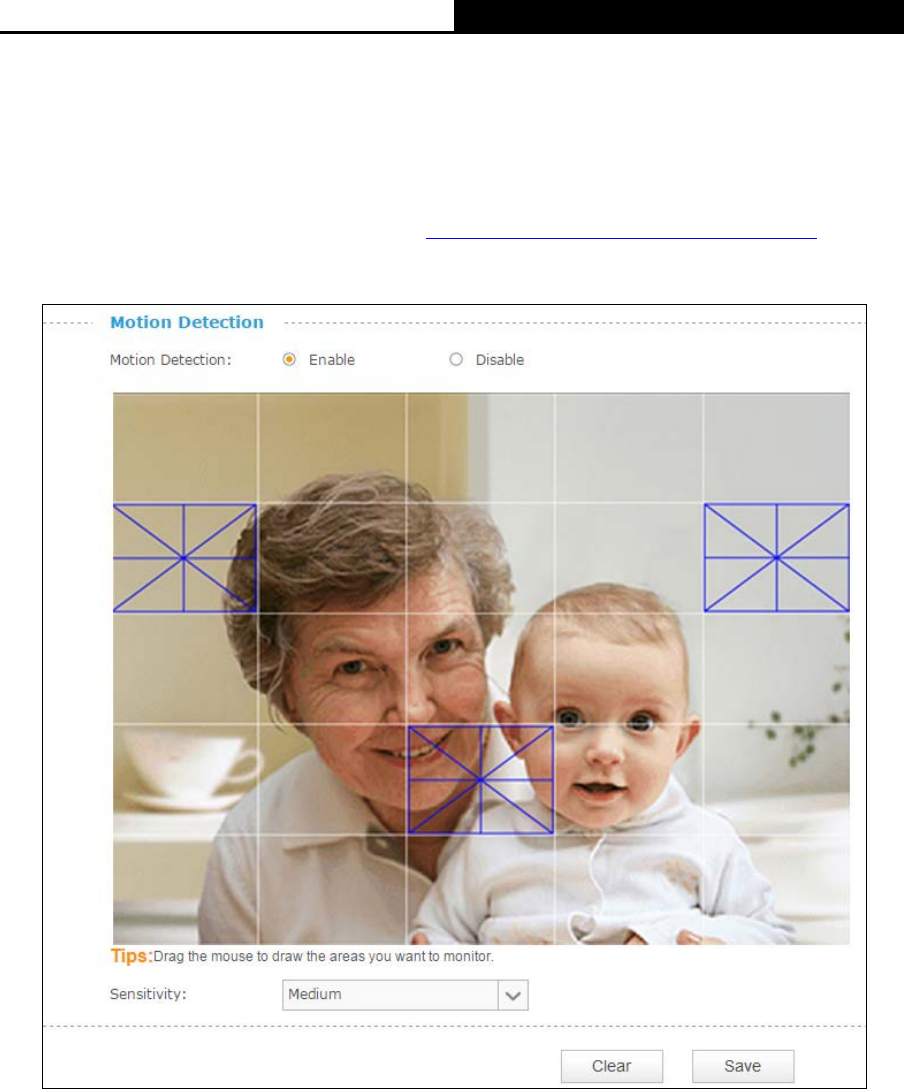
NC220
Day/Night Cloud Camera, 300Mbps Wi-Fi
Click Save to save and enable the settings.
3.4.8 Advanced → Motion Detection
Motion detection allows you to specify areas of your camera’s video to monitor for motion, which
can be used to trigger snapshots. Refer to 3.4.10 Advanced → Notification Delivery for more
details.
Motion Detection: To enable or disable the motion detection function.
Sensitivity: Specify the level of difference between two sequential images that would indicate
motion. Select one of the three levels of sensitivity from the drop-down list: High, Medium, and
Low.
Use your mouse to click on the parts of screen where you would like to monitor for motion. Click
Save to save and enable the settings.
27
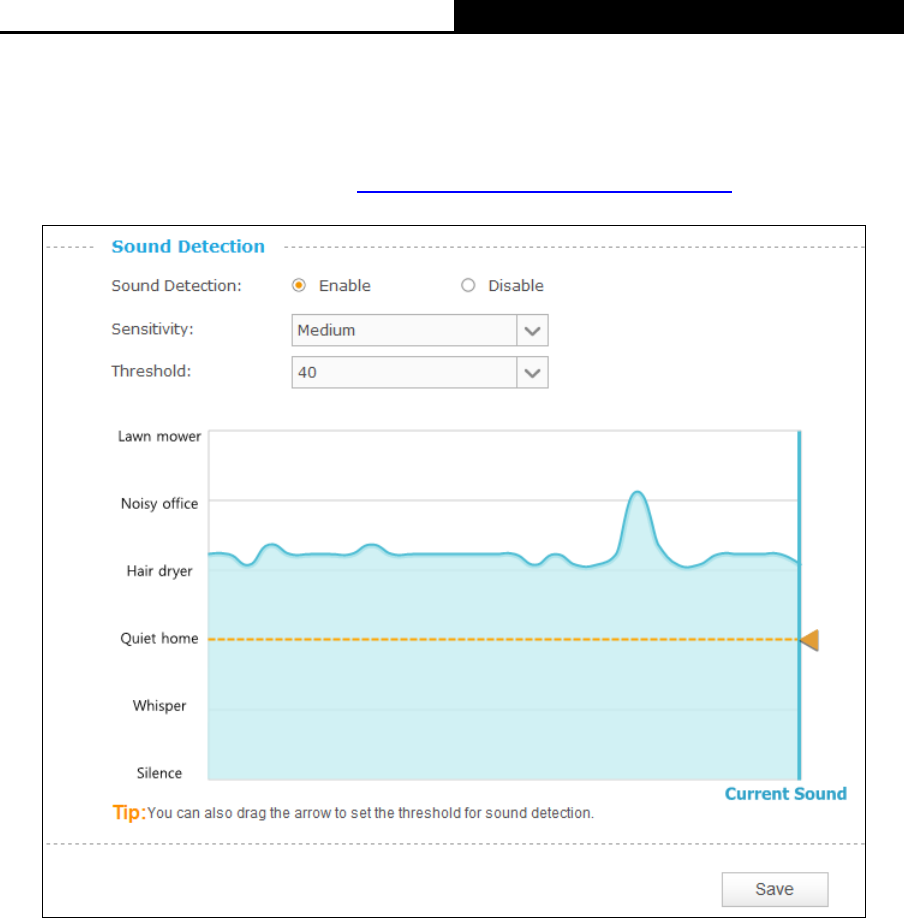
NC220
Day/Night Cloud Camera, 300Mbps Wi-Fi
3.4.9 Advanced → Sound Detection
Sound detection allows your camera to detect when there is a loud sound in the area, which can
be used to trigger snapshots. Refer to 3.4.10 Advanced → Notification Delivery for more details.
Sound Detection: To enable or disable the sound detection function.
Sensitivity: Specify the level of difference between current sound and the threshold you set.
Select one of the three levels of sensitivity from the drop-down list: High, Medium, and Low.
Threshold: Select the threshold of sound level. Snapshots will be triggered when current
sound exceeds this threshold. You can also drag the arrow in the diagram to set the threshold.
Click Save to save and enable the settings.
3.4.10 Advanced → Notification Delivery
Notification Delivery settings are available only after the motion detection or sound detection
function is enabled. Notification delivery function is used to inform you immediately by sending the
snapshots, which are triggered by the camera’s motion detection or sound detection function, to
the specified FTP server or E-mail address.
28
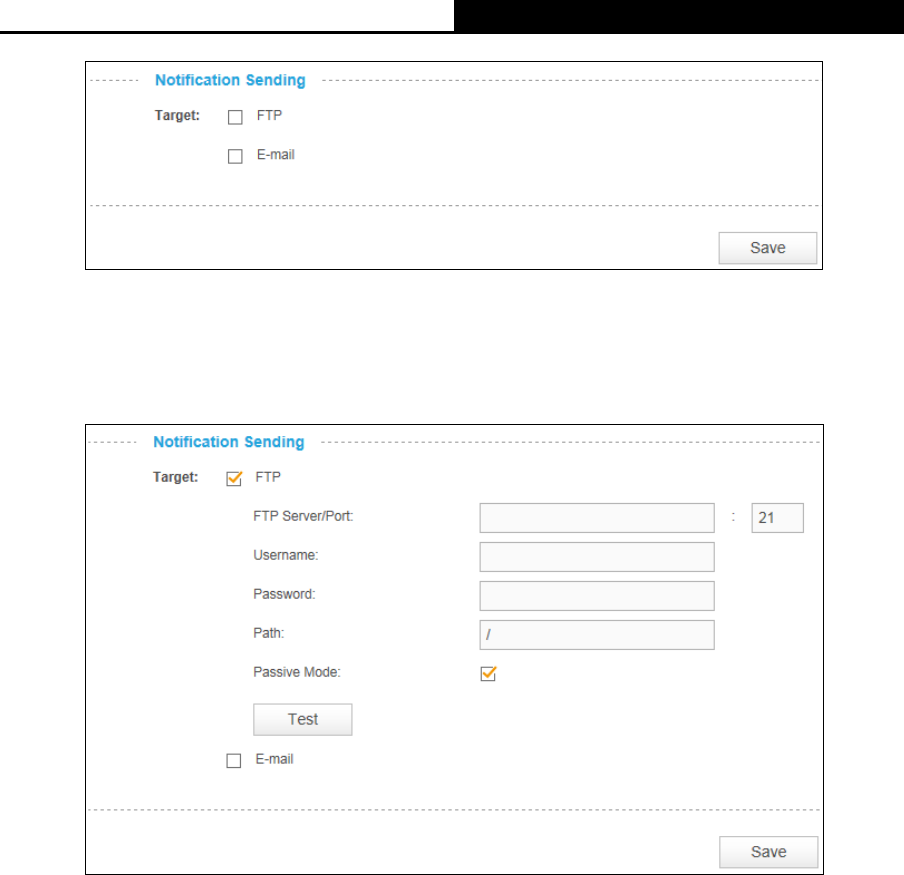
NC220
Day/Night Cloud Camera, 300Mbps Wi-Fi
FTP
Select FTP, you can configure your camera to send snapshots to a specified FTP sever on the
following screen:
FTP Server/ Port: Enter the IP or the domain (IP/domain without prefix ftp://) and the port of
the FTP server that you will be connecting to. The port is 21 by default.
Note:
The FTP server you set and the camera should be in the same LAN.
Username: Enter the username that is used to log in to your FTP server.
Password: Enter the password that is used to log in to your FTP server.
Path: Enter the path to the destination on the FTP server.
Passive Mode: Enabling passive mode may help you reach your FTP server if your camera is
behind a router protected by a firewall.
To set up a FTP to receive notification, follow the steps below:
29
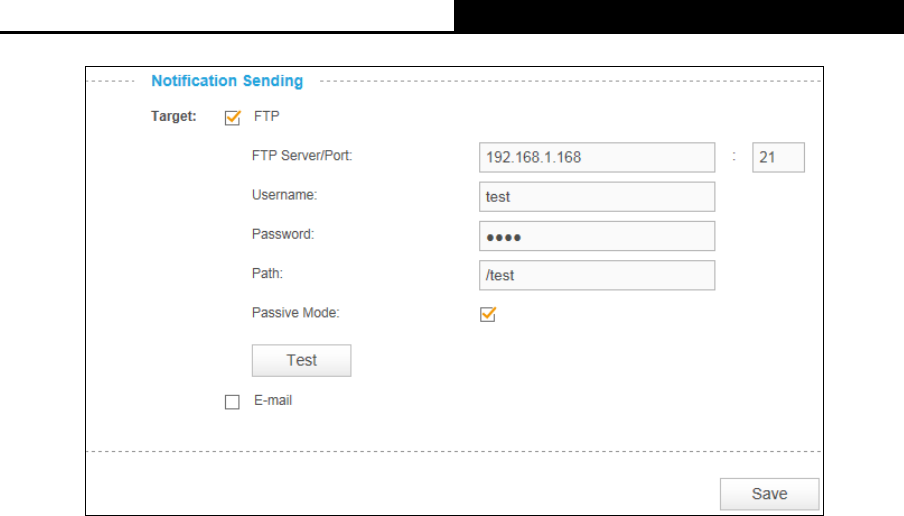
NC220
Day/Night Cloud Camera, 300Mbps Wi-Fi
1. Enter an IP address or domain of your FTP server, e.g. 192.168.1.168
2. Remain the FTP port number as the default value: 21.
3. Enter your username to log in to the FTP server, e.g. test.
4. Enter your password to log in to the FTP server.
5. Enter the path to the destination on the FTP server, e.g. /test
6. Enable Passive Mode.
7. Click Save to save and enable the settings.
Click Test, and a test JPEG snapshot will be sent to the specified FTP server to check whether
your settings are correct.
If the settings are tested correct, click OK.
If the settings are tested incorrect, check your network and FTP settings and try again later.
E-mail
Select E-mail, you can configure your camera to send snapshots to a specified E-mail address on
the following screen.
30
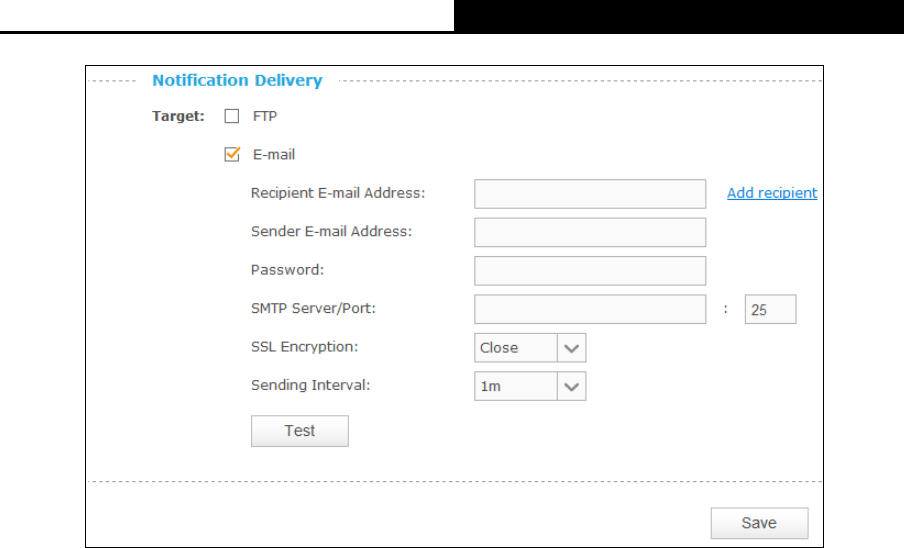
NC220
Day/Night Cloud Camera, 300Mbps Wi-Fi
Recipient E-mail Address: Enter the receiver’s E-mail address that the notification E-mail
will be sent to. Click Add recipient to add receiver’s E-mail addresses. You can specify up to
four recipient E-mail addresses.
Sender E-mail Address: Enter the sender’s E-mal address that is used to send the
notification E-mail.
Password: Enter your password if the SMTP server uses authentication.
SMTP Server/Port: Enter the domain name or IP address and the port of your external E-mail
server. The port is 25 by default.
SSL Encryption: Select TLS or STARTTLS as the SSL encryption; select Close to disable
SSL encryption.
Note:
If TLS is selected as the SSL Encryption, set the Sender E-mail Port as 465; if STARTTLS is
selected, set the Port as 25 or 587.
Sending Interval: Set the limit for how frequently E-mail notifications will be sent. Select one
interval from the drop-down list.
For example, if you want to use Gmail with TLS for E-mail notifications, follow the steps
below:
31
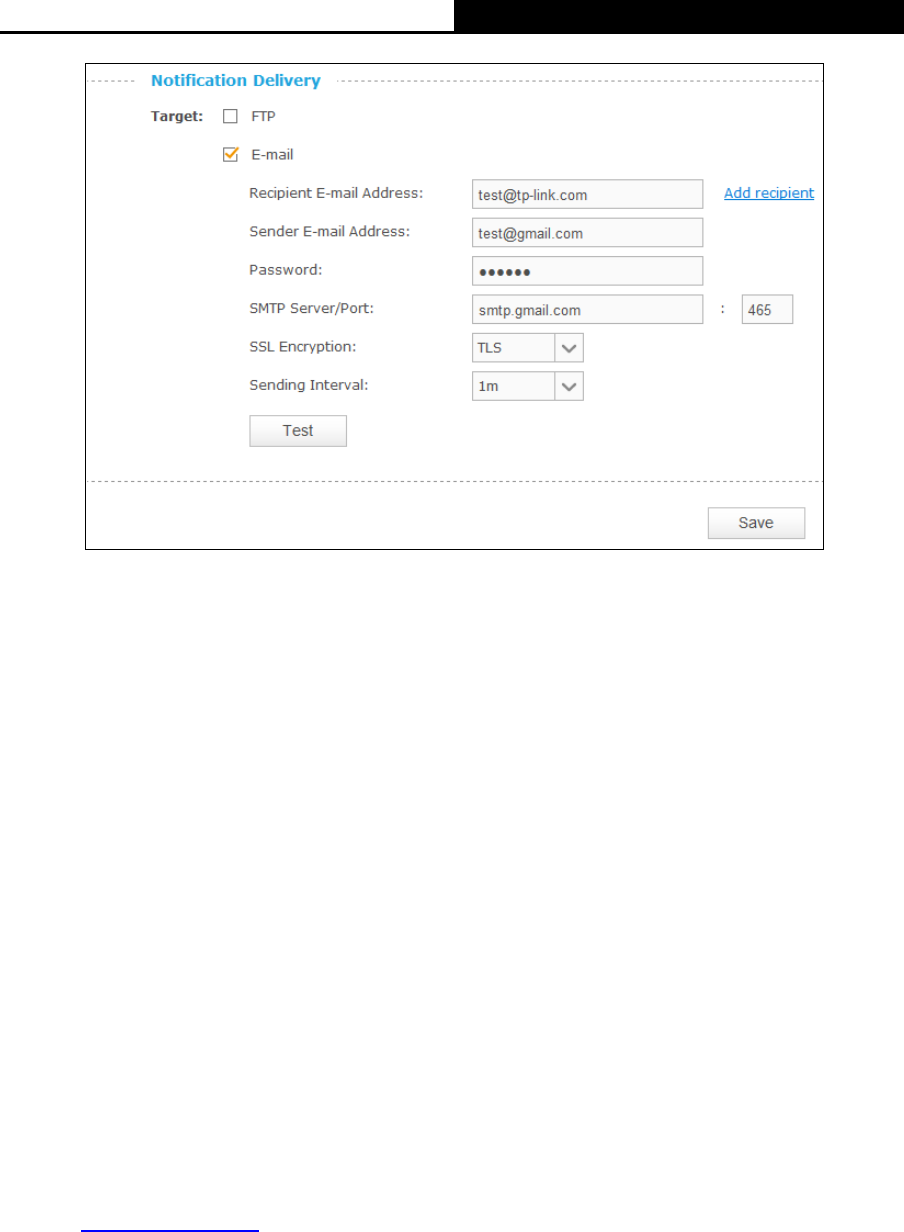
NC220
Day/Night Cloud Camera, 300Mbps Wi-Fi
1. Enter the receiver’s E-mail address in Recipient E-mail Address, e.g. test@tp-link.com.
2. Enter your Gmail E-mail address in Sender E-mail Address, e.g. test@gmail.com.
3. Enter the password required to access the SMTP server.
4. Enter smtp.gmail.com in SMTP server.
5. Select TLS as the SSL encryption and the SMPT server port number will be changed to 465
automatically.
6. Set the Sending Interval, e.g. 1m.
7. Click Save to save and enable the settings.
Click Test, and a test JPEG snapshot will be sent to the recipient E-mail address to check whether
your settings are correct.
If the settings are tested correct, click OK.
If the settings are tested incorrect, check your network and E-mail settings and try again later.
3.4.11 Advanced → LED
Refer to 3.3.5 Basic → LED.
3.5 System
Click the System folder to display the sub folders including Account, Date/Time, Management,
and System Log.
32
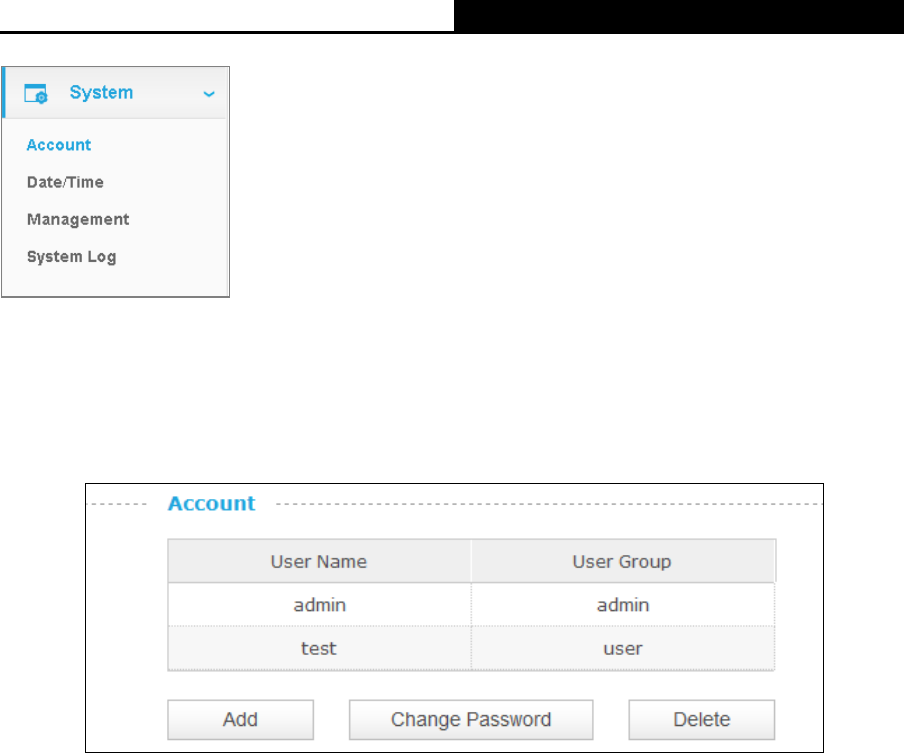
NC220
Day/Night Cloud Camera, 300Mbps Wi-Fi
3.5.1 Account
On this page, you can change the administrator’s password and manage the user account(s) that
are allowed to access to your camera.
Username: Displays the name of user account.
User Group: Displays the group that the user account is in. Different user group has different
limits of authority.
admin: This group has all authority of configuration. It can only have one account: admin.
user: This group can only view the Live View. It can have up to five accounts.
Add a New User Account
You can create a new user account to provide viewing access for your camera’s video. User
accounts will only be able to access the Live View section of the web configuration page, but
cannot access any other parts or change any settings.
To add a new user account, follow the steps below:
1. Click Add, and you will see the following screen.
33
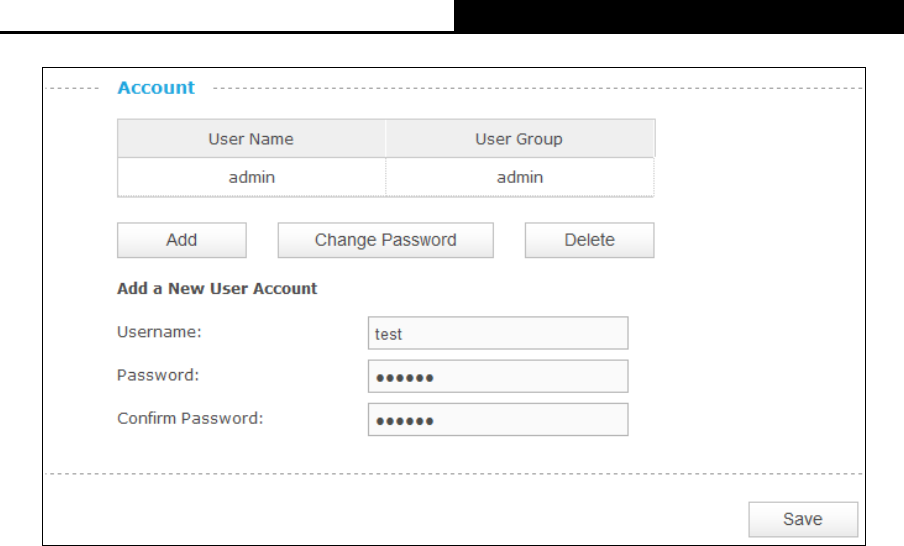
NC220
Day/Night Cloud Camera, 300Mbps Wi-Fi
2. Enter a username for your new account.
3. Enter a password for your new account. The password should contain 5 to 20 characters.
4. Enter the password again to confirm it.
5. Click Save to save and enable the settings.
Change Password
You can change the password of all the accounts here.
Note:
The default account and password are both admin. Everyone who knows the camera’s IP address
can access the device with all configuration authority. It is necessary to change the default
password if the device is intended to be accessed only by administrator.
To change password, follow the steps below:
1. Select a user account in the list whose password you want to change
2. Click Change Password, and you will see the following screen.
34
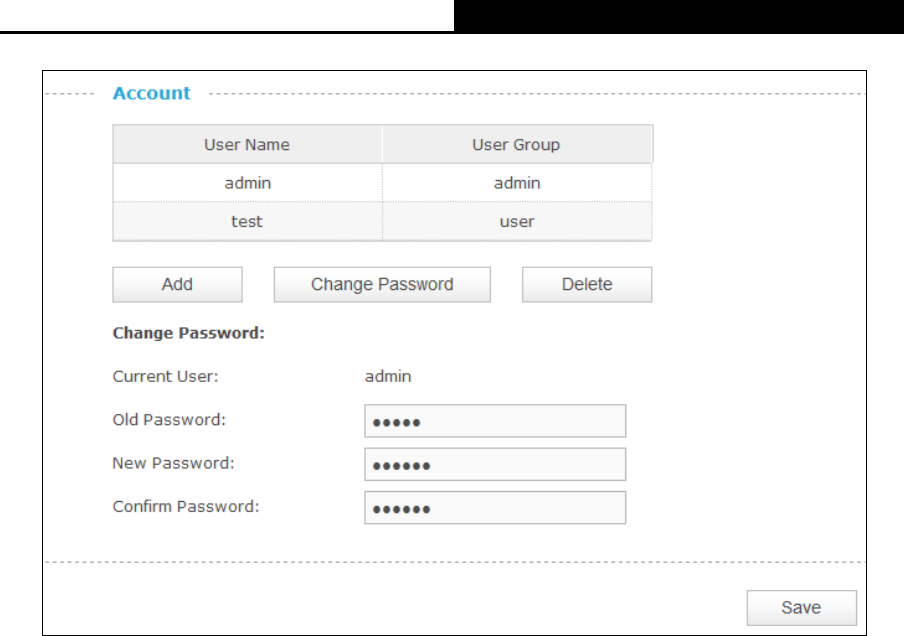
NC220
Day/Night Cloud Camera, 300Mbps Wi-Fi
3. Enter the current password in the Old Password textbox.
4. Enter a new password.
5. Enter the new password again to confirm it.
6. Click Save to save and enable the settings.
Delete a User Account
You can delete a user account except admin here. Select one in the list and click Delete.
3.5.2 Date/Time
On this page, you can configure the settings of the internal system clocks for your camera.
35
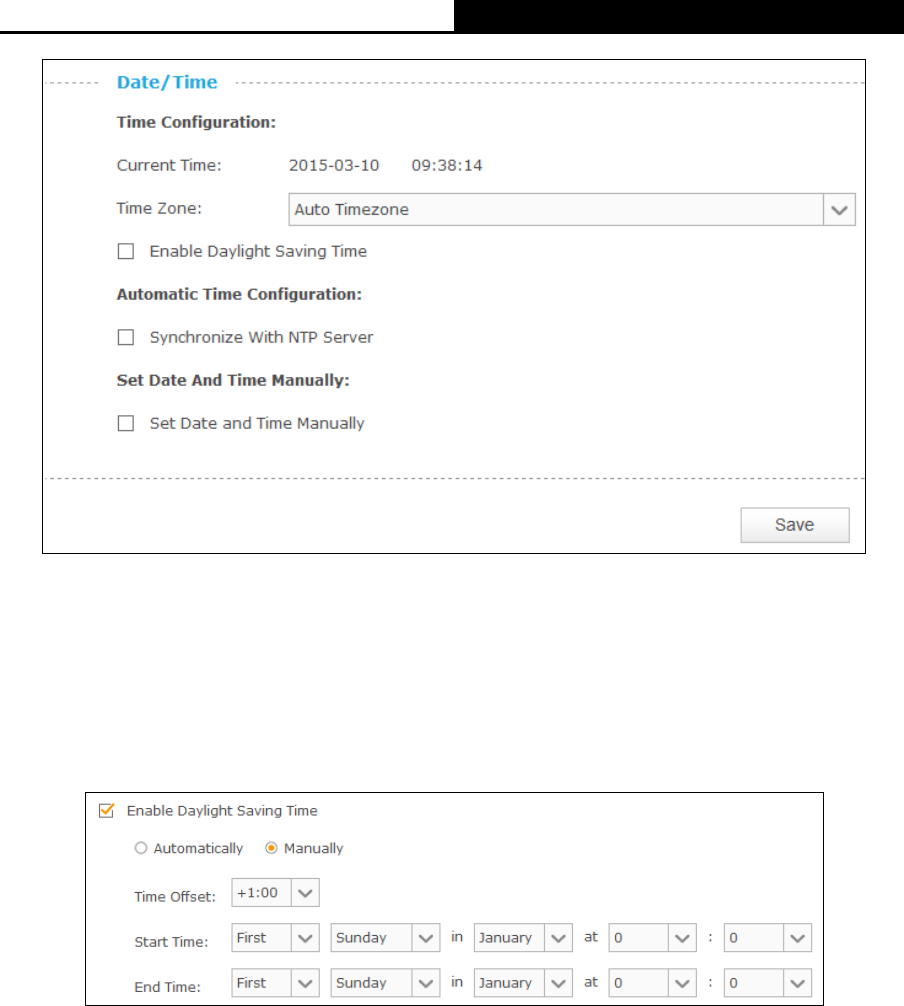
NC220
Day/Night Cloud Camera, 300Mbps Wi-Fi
Current Time: Displays the current date and time of the camera.
Time Zone: Select the time zone for the region where the camera is installed from the
drop-down list. Auto Time zone is recommended.
Enable Daylight Saving Time: Select this option to enable daylight saving time adjustment.
If enabled, you will see the following screen:
Automatically: If selected, the internal system clocks of the camera will adjust the DST
automatically.
Manually: If selected, you can adjust the DST by setting the Time Offset, Start Time, and
End Time.
Synchronize With NTP Server: Select this option to specify the NTP server name to
synchronize the date and time of the camera with those of the time server, known as the NTP
(Network Time Protocol) server. If enabled, you will see the following screen:
36
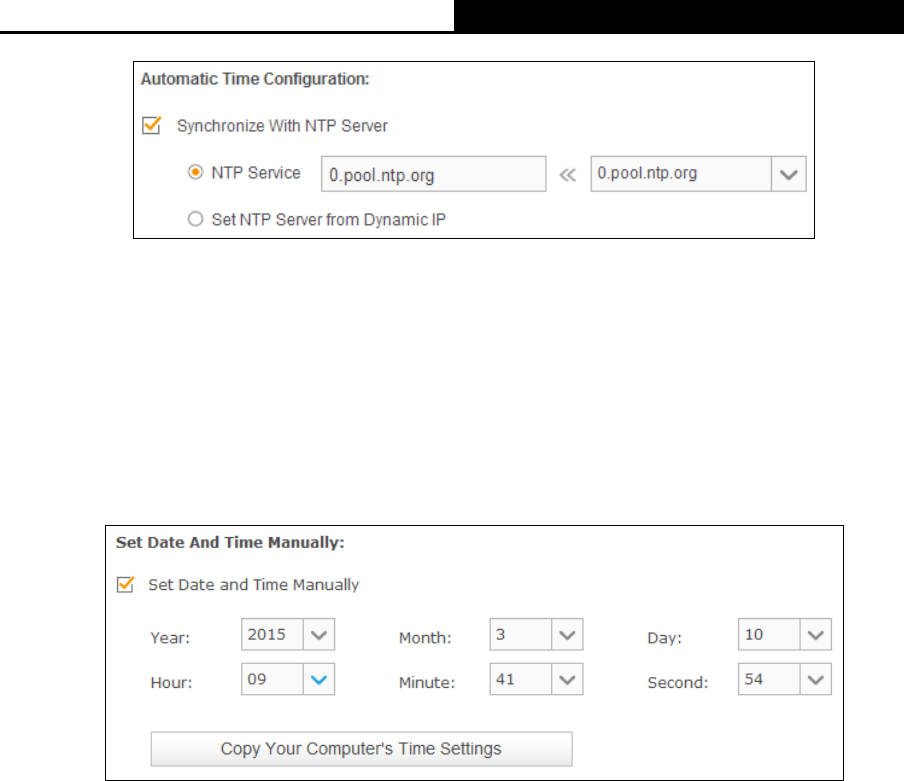
NC220
Day/Night Cloud Camera, 300Mbps Wi-Fi
NTP Server: You can either enter a domain name of the NTP server or select one which
will be filled in automatically from the drop-down list.
Set NTP Server from Dynamic IP: You can use the NTP server applied in the DHCP
server on the network.
Set Date and Time Manually: Select this option to set the date and time of the camera
manually. If enabled, you will see the following screen:
Copy Your Computer’s Time Settings: Click this button to copy your computer’s current
time settings.
Click Save to save and enable the settings.
3.5.3 Management
On this page, you can reboot the camera, backup and restore the camera’s current settings, reset
factory settings, and update the camera’s software.
37
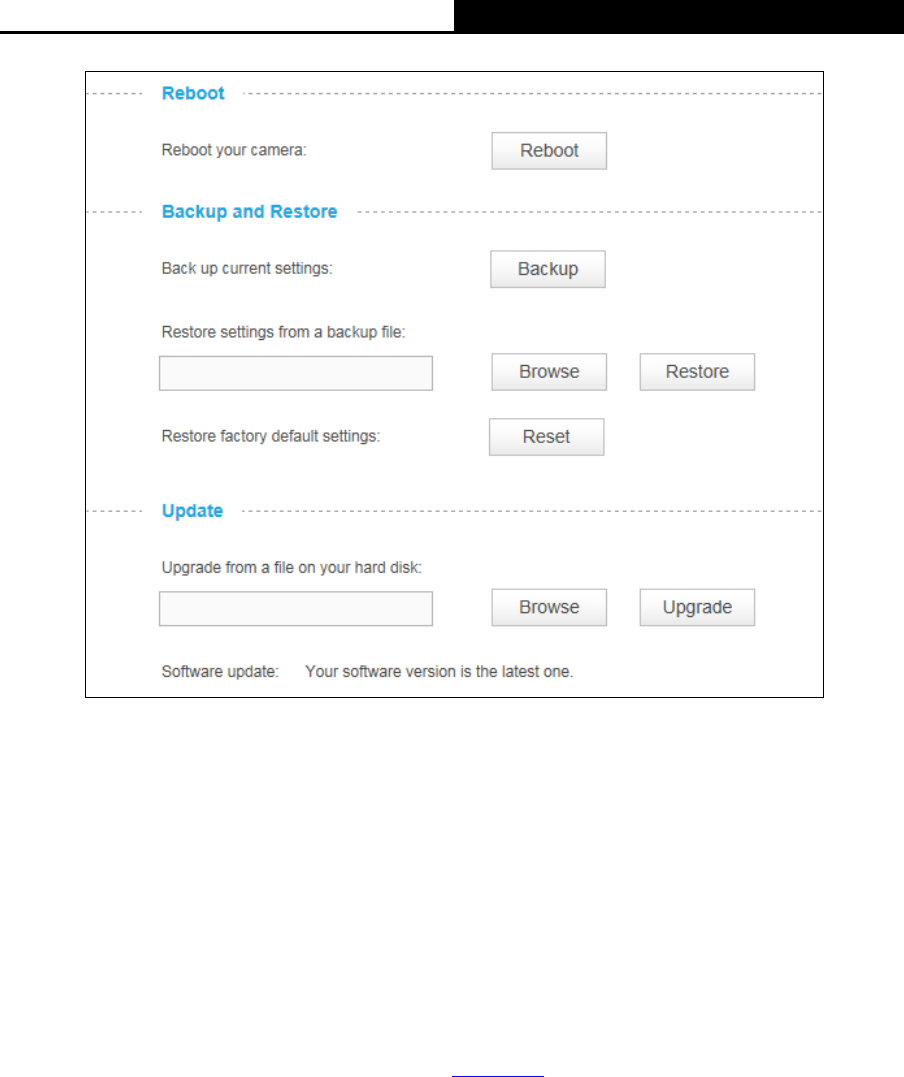
NC220
Day/Night Cloud Camera, 300Mbps Wi-Fi
Reboot: Click Reboot and then click Reboot on the pop-up screen to confirm. Rebooting will
not change the camera’s setting. After rebooting, you need to log in to this page again.
Backup: Click Backup and follow the instructions on the browser to save the setting data file
to your specified location.
Restore: Click Browse to locate the saved backup file and then click Restore. The camera
will start rebooting and then the settings will be restored to the previous configuration.
Reset: Click Reset and then click Reset on the pop-up screen to restore the camera to its
factory defaults. Don't turn off the camera while resetting. After resetting, you need to find out
the IP address of your camera (refer to 3.1 Login) and use the default username and
password (admin/admin) to log in to this page.
Update:
The system will detect whether your camera’s current software is the latest one automatically.
If the software is the latest one, you can see a note on the screen: Your software version is
the latest one.
If not, a screen will pop up for you to download the latest software and you can follow the
steps below to upgrade the software.
1. Click Download on the pop-up screen to download the latest software.
38
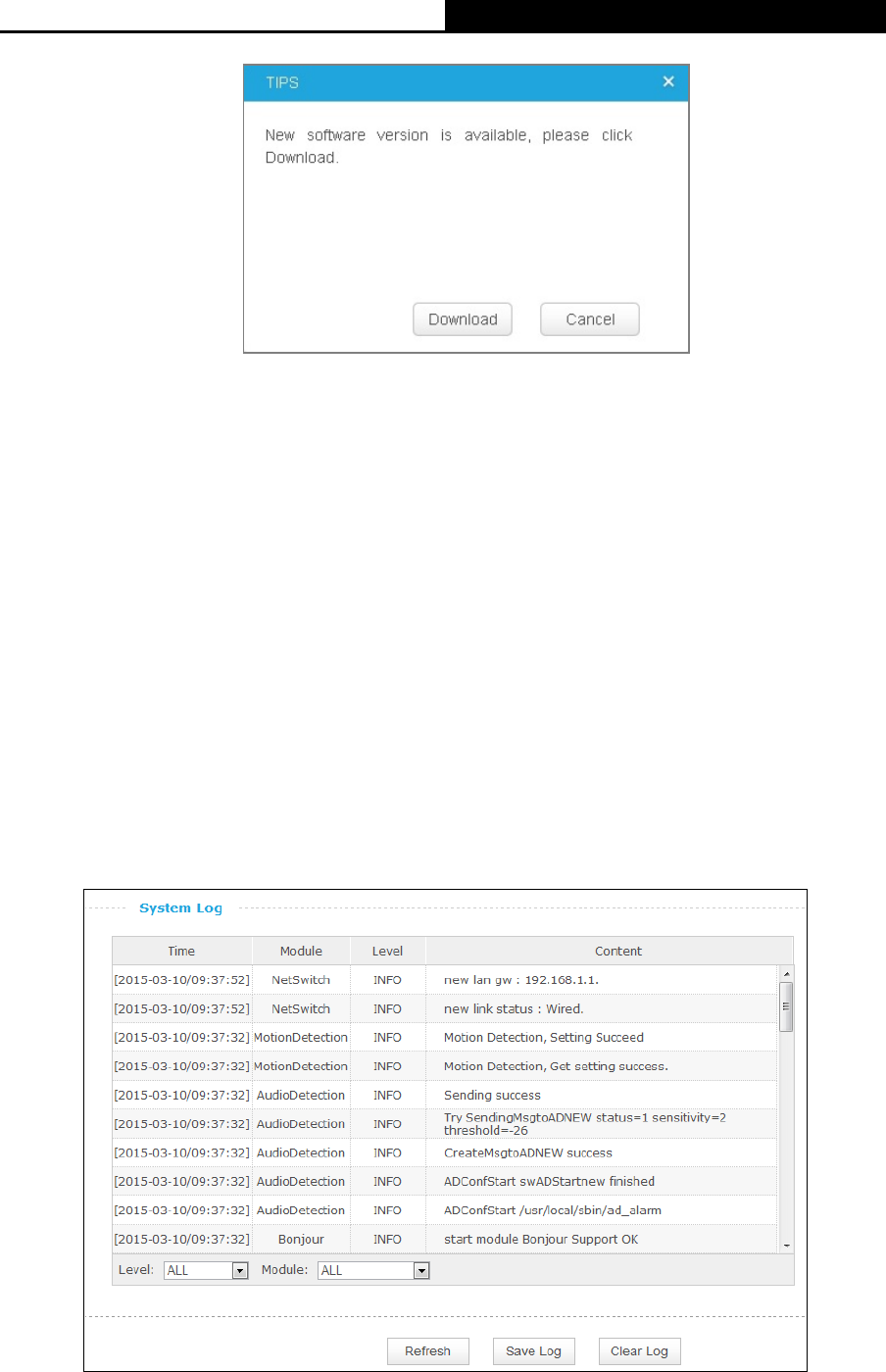
NC220
Day/Night Cloud Camera, 300Mbps Wi-Fi
2. Click Browse to locate the latest downloaded software.
3. Click Upgrade to update the camera’s software to the latest version.
4. Wait for the uploading process to complete, and the camera will reboot automatically.
Note:
1. We recommend that you use a wired connection for your camera and PC when upgrading
firmware.
2. The firmware upgrade procedure must not be interrupted or the camera may be damaged.
3. The firmware upgrade procedure is always risky and do not try to upgrade new firmware if it’s
not necessary.
3.5.4 System Log
On this page, you can review any changes and events happened to your camera. The system
starts logging automatically after startup.
Time: Displays the time when the log event occurs. The log can get the correct time after you
39

NC220
Day/Night Cloud Camera, 300Mbps Wi-Fi
configure on the Date/Time page. (go to Advanced → Date/Time)
Module: Displays the module to which the log information belongs. You can specify the
module by selecting one from the Module drop-down list at the bottom.
Level: Displays the severity level of the log information. You can specify the level by selecting
one from the Level drop-down list at the bottom.
Content: Displays the details of the log information.
Refresh: Click Refresh to refresh the log information.
Save Log: Click Save Log and follow the instructions on the browser to save the log as a text
file named log.txt to your specified location.
Clear Log: Click Clear Log to clear all the log information.
40

NC220
Day/Night Cloud Camera, 300Mbps Wi-Fi
Appendix A: Specifications
SYSTEM
Image Sensor 1/4’’ Progressive scan CMOS sensor
Resolution 0.3 Megapixel (640*480)
Lens F: 2.8, f: 3.85mm
Viewing Angle FOV=64°
Digital Zoom 4x Digital
Video/Image
Video Compression H.264
Frame Rate & Resolutions
Max: 20 fps at 640*480 (VGA)
Max: 30 fps at 320*240 (QVGA)
Video Streaming Controllable frame rate and bandwidth
Image
Rotation: Mirror, Flip, Mirror Flip
Configurable brightness, contrast, saturation
Overlay capabilities: time, date, text
Audio
Audio Communication 1-way
Audio Input Built-in microphone
Audio Compression PCM
Alarm and Event Management
Input Trigger Motion detection, sound detection
Notification Method E-mail, FTP
Network
Standards and Protocols
Bonjour, TCP/IP, DHCP, PPPoE, ARP, ICMP, FTP, SMTP,
Samba, NFS, DNS, NTP, UPnP, RTP, RTCP, HTTP, HTTPS,
41

NC220
Day/Night Cloud Camera, 300Mbps Wi-Fi
TCP, UDP
Security Multiple password-protected user levels
Wireless
Wireless Data Rate IEEE 802.11b/g/n, Up to 300Mbps
Frequency 2.4-2.4835GHz
Wireless Encryption WEP, WPA/WPA2, WPA-PSK/WPA2-PSK
Minimum System Requirements
Supported Browser
Microsoft Internet Explorer 7 or higher
Firefox 4.0 or higher
Safari 4.0 or higher
Chrome 5.0 or higher
Opera 12.0 or higher
Supported OS
Windows XP/Vista/7/8
Mac OS X 10.7 or higher
General
Certification CE, FCC, RoHS
Environment
Operating Temperature: 0°C ~ 40°C (32℉ ~ 104℉)
Storage Temperature: -20°C ~ 60°C (-4℉ ~ 140℉)
Operating Humidity: 10%-90% non-condensing
Storage Humidity: 5%-90% non-condensing
42

NC220
Day/Night Cloud Camera, 300Mbps Wi-Fi
Appendix B: Troubleshooting
Question Answer or Resolution
Features
The maximum number of
users accessing the
camera simultaneously.
The maximum number of users is limited to 13. However, it also
depends on the total bandwidth accessed to this camera from
clients. The actual number of connected clients varies by
streaming mode, settings of resolution, frame rate and
bandwidth. Obviously, the performance of the each connected
client will slow down when many users are logged on.
The camera can be used
outdoors or not.
The camera is not weatherproof. It needs to be equipped with a
weatherproof case for outdoors using. However, equipped with a
weatherproof case might disable
the audio function of the
camera.
Install this camera
System
LED does not
light up.
Check and confirm that the DC power adaptor, included in
package, is used. Secure the power connector and re-power it
on again.
If the problem is not solved, the camera
might be faulty.
Contact your dealer for further help.
The camera will be
installed and work if a
firewall exists on the
network.
If a firewall exists on the network, port 80 is open for ordinary
data communication. The HTTP port needs to be opened on the
firewall or NAT router.
The username and
password for the first time
or after factory default
reset
Username is admin and password is admin.
Note that it’s all case sensitive.
Forgot the username and
password
Follow the steps below.
1. Restore the factory default setting by pressing and holding
the WPS/RESET button (more than 5 seconds)
on the
camera.
2. Reconfigure the camera.
Forgot the IP address of
the camera.
Run the Setup Wizard. The IP address is displayed on the
Select a camera screen.
Find the IP a
ddress on the DHCP setting page of the front
device such as router.
Internet Explorer does not
seem to work well with the
camera
Make sure that your Internet Explorer is version 7
.0 or later. If
you are experiencing problems, try upgrading to the latest
v
ersion of Microsoft’s Internet Explorer from the Microsoft
webpage.
UPnP NAT Traversal
Cannot work with NAT
Maybe NAT router does not support UPnP function. Please
43

NC220
Day/Night Cloud Camera, 300Mbps Wi-Fi
router
check user’s manual of router and turn on UPnP function.
Maybe UPnP function of NAT router is not compatible to the IP
camera. Please contact your dealer to get the approval routers
list.
Some
cameras are
working but others are
failed
Maybe too many cameras have been installed on the LAN, and
then NAT router is out of resource to support more cameras.
You could turn off and on NAT router to clear out of date
information inside router.
Access this camera
Cannot access the web
management
page and
other web pages of the
camera
from Internet
Explorer
Maybe the IP Address of the camera is already being used by
another camera or computer. To confirm this possible problem,
disconnect the camera from the network first, and then run the
PING utility to check it out.
May be due to the network cable. Try correcting your network
cable and confi
guration. Test the network interface by
connecting a local computer to the camera via a crossover
cable.
Make sure the Internet connection and setting is ok.
Make sure the IP address typed in is correct. If the camera has
a dynamic address, it may have ch
anged since you last
checked it.
Network congestion may prevent the web page appearing
quickly. Wait for a while.
The IP address and Subnet Mask of the PC and camera must
be in the same class of the private IP address on the LAN.
Make sure the http port us
ed by the camera, default=80, is
forward to the camera’s private IP address.
The port number assigned in your camera might not be
available via Internet. Check your ISP for available port.
The proxy server may prevent you from connecting directly to
the camera, set up not to use the proxy server.
Confirm that Default Gateway address is correct.
The router needs Port Forwarding feature. Refer to your
router's manual for details.
Packet Filtering of the router may prohibit access from an
external network. Refer to your router's manual for details.
Access the camera from the Internet with the global IP address
of the router and port number of camera.
Some routers reject the global IP address to access the
camera on the same LAN. Access with the private IP address
and correct port number of camera.
When you use DDNS, you need to set Default Gateway and
DNS server address.
If it’s not working after above procedure, reset camera to
default setting and installed it again.
If the problem is not solved, the camer
a might be faulty.
Contact your dealer for further help.
Image or video does not
appear in the main page.
Make sure the plugin is installed properly and
your browser
security settings are set to allow plugins. Close and restart the
browser. Try to browse and log in again.
When using Windows XP, or Vista, log on with an appropriate
44

NC220
Day/Night Cloud Camera, 300Mbps Wi-Fi
account that is authorized to install applications.
Network congestion may prevent the Image screen from
appearing quickly. You may choose lower resolution to reduce
the required bandwidth.
The camera work locally
but not externally.
Might be caused from the firewall protection. Check the
Internet firewall with your system or network administrator. The
firewall may need to have some settings changed in order for
the camera to be accessible outside your LAN.
Make sure that the camera isn’t conflicting with any other web
server running on your LAN.
Check the configuration of the router settings allow the camera
to be accessed outside your local LAN.
Check the bandwidth of Internet c
onnection. If the Internet
bandwidth is lower than target bit rate, the video streaming will
not work correctly.
The unreadable
characters are displayed.
Use the operating system of the selected language. Set the
Encoding or the Character Set of the selected language on the
Internet Explorer.
Frame rate is slower than
the setting.
The traffic of the network and the object of the image affect the
frame rate. The network congestion causes frame rate slower
than the setting.
Check the bandwidth of Internet
connection. If the Internet
bandwidth is lower than target bit rate, the video streaming will
not work correctly.
Ethernet switching hub can smooth the frame rate.
Image Transfer on e-mail
or FTP does not work.
Default Gateway and DNS server address sho
uld be set up
correctly.
If FTP does not work properly, ask your ISP or network
administrator about the transferring mode of FTP server.
Video quality of the camera
The focus on the camera
is bad.
The lens is dirty or dust is attached. Fingerprints, dust, stain,
etc. on the lens can degrade the image quality.
The color of the image is
poor or strange.
To insure the images you are viewing are the best they can be,
set the Display property setting (color quality) to 16bit at least
and 24 bit or higher if possible within your computer.
The configuration on the camera image display is incorrect.
You need to adjust the image related parameters such as
brightness, contrast, and saturation properly.
Image flickers.
Wrong power line frequency makes images flicker. Make sure
the 50 or 60Hz format of your camera.
If the object is dark, the image will flicker. Make the condition
around the camera brighter.
Miscellaneous
Cannot play the recorded
file
Have installed Microsoft®’s DirectX 9.0 or later and use the
Windows Media Player 11.0 or later to play the AVI filed recorded
by the camera.
45